.
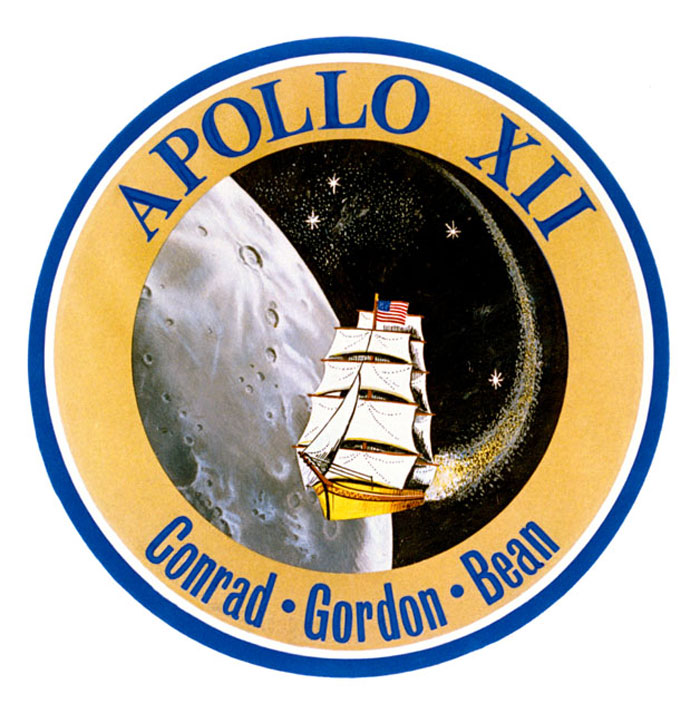
Mission Highlights
Apollo 12 launched from Cape Kennedy on Nov. 14, 1969, into a cloudy, rain-swept sky. Launch controllers lost telemetry contact at 36 seconds, and again at 52 seconds, when the Saturn V launch vehicle was struck by lightning. The booster's first stage continued firing, launching Apollo 12 into an initial Earth-parking orbit of 115 by 117.9 miles. After one-and-a-half revolutions, the electrical circuits were checked out and no significant problems were noted. Then, the S-IVB stage re-ignited for a second burn of five minutes, 45 seconds, placing Apollo 12 into an initial free-return translunar trajectory.
About 40 minutes later, the CSM Yankee Clipper separated from the S-IVB-SLA, transposed, and then docked with the LM Intrepid. This was televised on Earth. The S-IVB stage was then jettisoned. However, based on incorrect data of trajectory commands, it failed to go into the planned heliocentric orbit. Instead, it was placed into an elliptical Earth-orbit of 101,350 by 535,522 miles, with a period of 42 days. Charles Conrad and Alan Bean entered the LM to check for possible impacts from the lightning strike. They found none and re-entered the CSM for 10 hours of sleep.
On Nov. 15, the second telecast occurred en route to the moon, showing the interior of the Yankee Clipper. Only one midcourse maneuver was needed. It changed Apollo 12's trajectory to prepare for later insertion into a non-free-return lunar orbit - the first "hybrid" trajectory in Apollo flights. The spacecraft slowed so that it would arrive with the most desirable solar illumination on the selected Site 7.
Prior to lunar orbit insertion, a third telecast was made to Earth on Nov. 17, showing the Earth, moon, spacecraft interior and intravehicular transfer of the crew. Later that day, when Apollo 12 went behind the moon at about 97 miles up, the first lunar orbit insertion burn began. The burn lasted for about six minutes, placing the spacecraft into an elliptical orbit of 69 by 195 miles.
On Nov. 18, two orbits later and again on the far side of the moon, a second lunar orbit insertion burn altered Apollo 12 to an orbit of 62 by 76 miles. It was calculated to eventually circularize for the orbit of the solo CSM due to lunar-gravity potential. This would facilitate subsequent rendezvous and docking of Intrepid and the Yankee Clipper in their moon-parking orbit after the scheduled lunar landing. The same day, Conrad and Bean entered the LM and a telecast to Earth was made of the separation of the CSM and LM occurring 107 hours, 54 minutes into the flight.
On Nov. 19, with the LM behind the moon in the 14th orbit, and some 109 hours, 23 minutes into the mission, the descent orbit insertion maneuver began. The LM decent engine, or LMDE, fired for 29 seconds, lowering Intrepid's orbit to about 9 by 69 miles. After the LM emerged from behind the moon and telemetry contact was re-established with Earth, a discrepancy was noted between orbit data readings from Intrepid and those displayed in Apollo Mission Control in Houston. The LM was initially believed to be in an incorrect descent orbit trajectory for landing in the desired region, due to normal mission anomalies. Using a newly developed "Lear" powered-flight data processor in Houston, the actual trajectory data, as well as correction maneuver information, were fed by voice to the LM crew. This enabled them to update the automatic downrange navigation computer program, shortening the range by 4,190 feet and permitting the precision touchdown at the intended site. This update to a satisfactory trajectory occurred about two minutes after the LM began its powered descent, which had been initiated at about 110 hours, 20 minutes into the mission and lasted a mere nominal 40 seconds longer than the preflight plan had scheduled. With Conrad controlling the descent semi-manually for the last 500 feet, a precision landing occurred at about 110 hours, 32 minutes into the mission, and closer to the target than expected. Intrepid landed in the Ocean of Storms at 3 degrees, 11 hours, 51 minutes south, and 23 degrees, 23 minutes, and 7.5 seconds west. Landing was about 120 feet northeast of Head Crater, and about 535 feet northwest from where Surveyor III stood in its crater. Apollo 12 touched down approximately 950 miles west of where Apollo 11 had landed.
Three hours after the landing and before the first extravehicular activity or, EVA, began. Richard Gordon, orbiting 69 miles up in the Yankee Clipper, was able to see both the Intrepid and Surveyor through the use of a 28-power sextant telescope. Conrad opened Intrepid's hatch at 115 hours, 10 minutes into the mission to begin the first lunar EVA for the Apollo 12 crew. In their first lunar exploration, Conrad spent three hours, 39 minutes outside Intrepid, and Bean logged two hours, 58 minutes on the lurain. During this EVA, Conrad collected lunar surface samples and deployed both the S-band communication antenna and the solar wind experiment. Bean was assigned to mount the TV camera on a tripod. In the process of doing so, it was inadvertently pointed into the sun and ceased to function. The ALSEP instrumentation and SNAP-27 RTG were deployed within an arc of 600 to 700 feet of the LM. The ALSEP functioned satisfactorily, except for two items in the package, and was expected to yield data for up to two years. Deployment of the ALSEP took about an hour to complete. Throughout this first EVA, Conrad and Bean also took photographs of the experiment equipment, the spacecraft, the lurain and of themselves. Before entering the Intrepid, Bean took a 16-inch-deep core sample of the lunar surface and was followed back into the LM by Conrad. The first EVA ended at 119 hours, five minutes into the mission. The crew then ate, recharged their backpacks, prepared for the second EVA the following day, and slept for about five hours.
On Nov. 20, an hour and a half earlier than planned, the crew began the second EVA. Conrad left the Intrepid some 131 hours, 28 minutes into the mission. The second EVA included the collection of 70 pounds of rock and dirt samples, the retrieval of 10 to 15 pounds of randomly selected selenological samples, and further probing of two areas to retrieve lunar material from depths up to 32 inches below the surface. The crew retrieved the TV camera and stored it in the LM for return to Earth. The most important part of this second EVA was a 5,200-foot traverse of the lurain, ranging up to 1,300 feet from Intrepid. Walking northwest to the site of the ALSEP deployment, Conrad and Bean then turned south to perform a selenological rock survey. They skirted the rim of Head Crater, walked further south past Bench Crater, west around Sharp Crater, and back east past Bench Crater again, south of Halo Crater. Eventually they turned northeast, entering the 650-foot-wide Surveyor Crater to retrieve parts of Surveyor III, which was perched some 150 feet from the edge at the southern quadrant.
During the exploration, the astronauts discussed their findings by voice communication with geologists in Houston, who provided advice about which samples to retrieve. Surveyor was extensively photographed before parts were retrieved. The 17-pound TV camera was severed from its mount so that extensive studies could be performed on Earth of its gears, motors, optics, metals and lubricants. This would help determine the long-term effects of exposure to the elements. Similarly, the Surveyor's motorized scoop, and pieces of TV cable, aluminum tubing and glass were gathered. Scientists on Earth were particularly interested in the cable because biological organisms had been trapped within it, and they wanted to know if any had survived.
Conrad and Bean then walked north, up a slope of about 14 degrees into Block Crater located on the rim of Surveyor Crater. They then turned west back to Intrepid, gathering surface samples as they went. They returned to the spacecraft at 134 hours, 49 minutes into the mission. Bean re-entered the LM at about 135 hours, 10 minutes, and Conrad followed at 135 hours, 22 minutes. The second EVA lasted three hours, 48 minutes. The crew removed their pressurized suits and jettisoned them on the moon before eating a meal.
Approximately six hours later on the same day, after a total of 31.6 hours on the moon, the LM ascent stage fired for about seven minutes, putting Intrepid into an initial orbit of 10 by 54 miles for rendezvous and docking with the Yankee Clipper. About three and a half hours later, the rendezvous and docking maneuvers were televised to Earth by Gordon.
Following transfer to the CSM, the ascent stage jettisoned and deorbited to impact the moon. This provided predictable impact data for the ALSEP seismometer. Although planned to impact about six miles from the ALSEP, it landed about 40 miles away. The combined length and severity of the seismic disturbance set up by the impact, estimated to equal that of one ton of TNT. To the surprise of seismologists, strong signals lasted for more than a half hour, and weaker signals ceased about an hour later. The effects were studied, as was the data received from other experiments left on the moon.
A heavy schedule of photographing future landing sites on the lunar surface occurred from the CSM, preceded by a change of plane maneuver 3.8 degrees to the north, on the 39th lunar revolution. The maneuver was performed by a 19-second burn of the service propulsion system, or SPS. Earlier, while the Yankee Clipper was in its 27th and 28th revolutions, Gordon conducted the multi-spectral photographic survey of the lunar surface. During the 45th revolution and the 89th hour of the mission, the SPS ignited to put Apollo 12 into a trans-Earth trajectory. The trajectory occurred 172 hours, 27 minutes into the mission Nov. 21.
The return flight was uneventful. A midcourse correction maneuver occurred Nov. 22, when Apollo 12 was about 208,000 miles from Earth. On Nov. 23, when the spacecraft was 108,000 miles from Earth, the crew held a televised news conference, followed by sleep. A second scheduled midcourse correction maneuver was not needed. On Nov. 24, following the same nominal re-entry procedure scheduled for Apollo 11, Apollo 12 ended its 10-day flight by splashing down in the Pacific Ocean at 15 degrees, 46.6 minutes south latitude, and 165 degrees, 9 minutes west. Splashdown occurred about three miles from the target area, and three miles south of and within sight of the recovery ship USS Hornet. The splashdown occurred about 400 miles southeast of American Samoa, after a flight of 244 hours, 36 minutes, 25 seconds - just 62 seconds longer than planned.
-
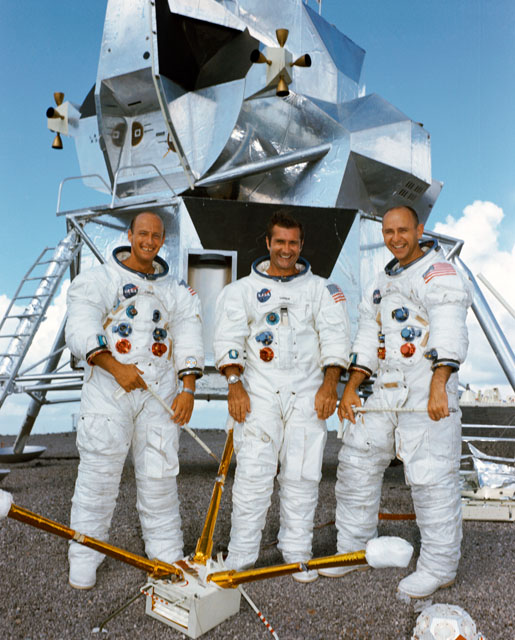
S69-38992 (September 1969) --- These three astronauts have been named by the National Aeronautics and Space Administration (NASA) as the prime crew of the Apollo 12 lunar landing mission. Left to right, are Charles Conrad Jr., Richard F. Gordon Jr., and Alan L. Bean.
-

S69-39262 (23 June 1969) --- Lunar Module (LM) 6, scheduled for the Apollo 12 lunar landing mission in November 1969, is being moved to an integration work stand in the Kennedy Space Center's (KSC) Manned Spacecraft Operations Building. The two prime crew members scheduled to use the LM-6 to descend to the lunar surface following separation from the Command and Service Modules (CSM) and to later return to the CSM are astronauts Charles Conrad Jr., commander, and Alan L. Bean, lunar module pilot. Astronaut Richard F. Gordon Jr. is the prime crew's command module pilot.
-
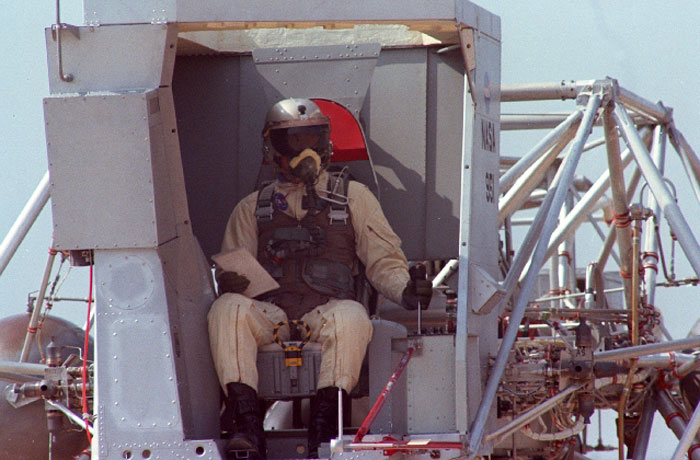
S69-56056 (25 Oct. 1969) --- Astronaut Charles Conrad Jr., Apollo 12 commander, sits in the cockpit of a Lunar Landing Training Vehicle during a training exercise designed to help the mission commander practice lunar landing techniques with the Lunar Module.
.
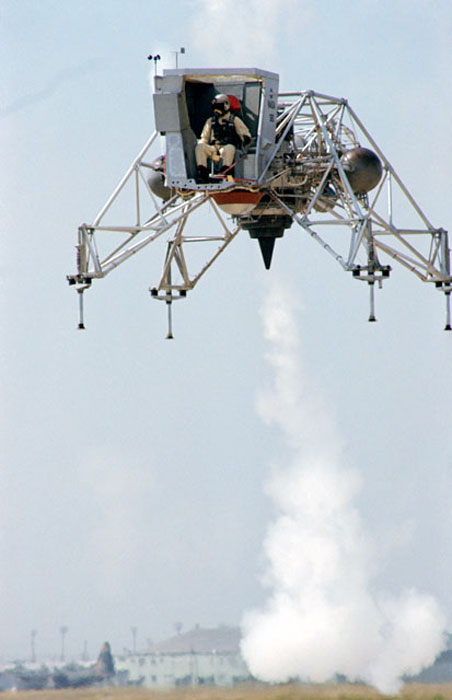
S69-56058 (25 Oct. 1969) --- Astronaut Charles Conrad Jr., commander of the Apollo 12 lunar landing mission, sits in the cockpit of a Lunar Landing Training Vehicle (LLTV) during a lunar simulation flight at Ellington Air Force Base. The LLTV is used to train Apollo crews in lunar landing techniques.
.
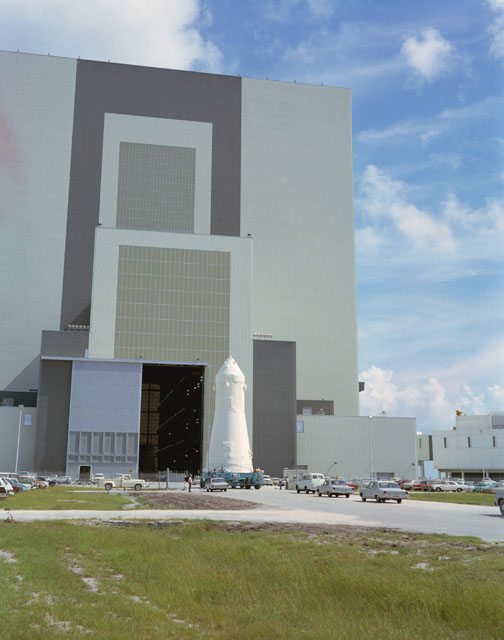
S69-39323 (1969) --- The Apollo 12 spacecraft (Command and Service Modules 108/Lunar Module 6) arrives at the Kennedy Space Center's Vehicle Assembly Building (VAB) during preflight preparations. The spacecraft had just been moved from the Manned Spacecraft Operations Building.
-
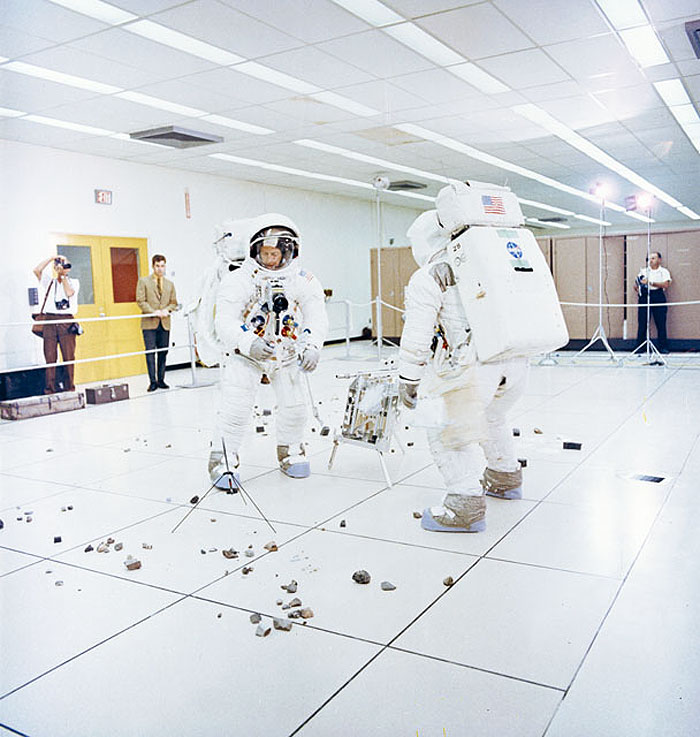
S69-55368 (6 Oct. 1969) --- Two members of the Apollo 12 lunar landing mission participate in lunar surface extravehicular activity (EVA) simulations in the Flight Crew Training Building at the Kennedy Space Center (KSC). Astronaut Charles Conrad Jr., commander (facing camera), simulates picking up samples. Astronaut Alan L. Bean, lunar module pilot, simulates photographic lunar rock sample documentation.
-
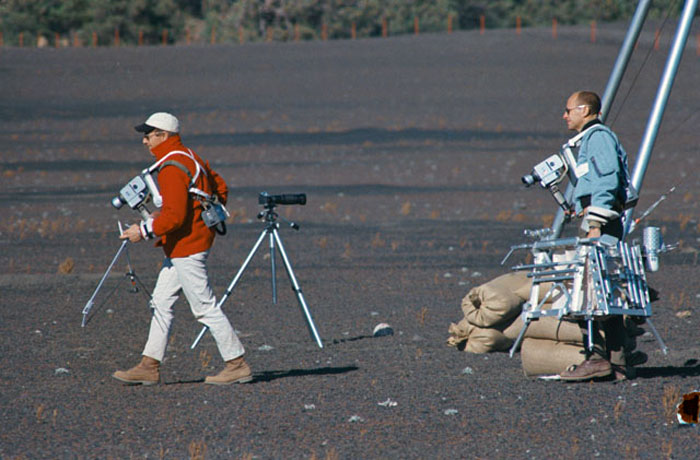
S69-55667 (10 Oct. 1969) --- Astronauts Charles Conrad Jr. and Alan L. Bean train for their upcoming Apollo 12 lunar landing mission. Here they are entering a simulated lunar surface area near Flagstaff, Arizona. Both are wearing lunar surface cameras strapped to their bodies. Conrad (left), the Apollo 12 mission commander, is carrying some of the tools from the geological tool container. The geological tool container, being carried here by Bean, the lunar module pilot, is similar to the one which will be used during scheduled extravehicular activity (EVA) periods on Nov. 19 and 20, 1969, on the lunar surface. While astronauts Conrad and Bean conduct their scheduled EVA on the moon's surface, astronaut Richard F. Gordon Jr., command module pilot, will man the Command and Service Modules (CSM) in lunar orbit
.

S69-56702 (22 Oct. 1969) --- Astronaut Richard F. Gordon Jr., Apollo 12 command module pilot, participates in simulation training at the Kennedy Space Center (KSC). Apollo 12 will be the National Aeronautics and Space Administration's (NASA) second lunar landing mission. The other two crew men are astronauts Charles Conrad Jr., commander; and Alan L. Bean, lunar module pilot.
-

S69-58005 (10 Nov. 1969) --- An artist's concept of the Apollo 12 Command Module's (CM) interior, with the command module pilot at the controls. The Apollo 12 Lunar Module (LM) and a portion of the lunar surface are seen out of the window. Astronaut Richard F. Gordon Jr. will maneuver the Apollo 12 Command and Service Modules (CSM) in lunar orbit while astronauts Charles Conrad Jr., commander, and Alan L. Bean, lunar module pilot, explore the moon.
.
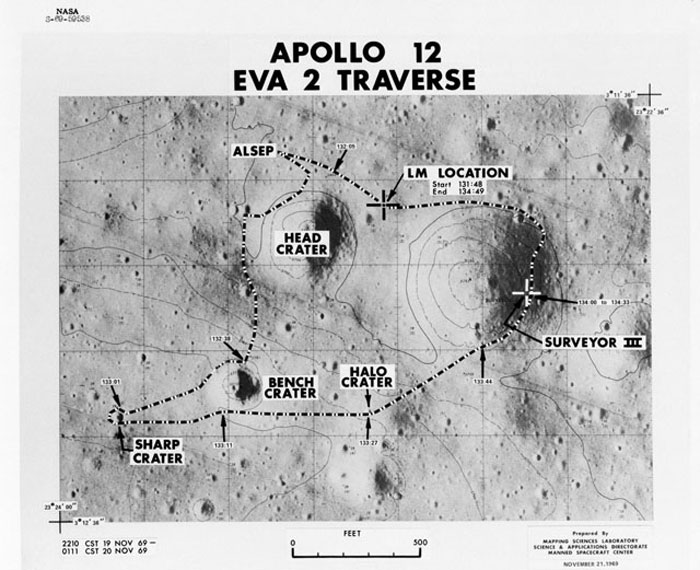
S69-59538 (November 1969) --- Apollo 12 extravehicular activity (EVA-2) Traverse Overlay.
-
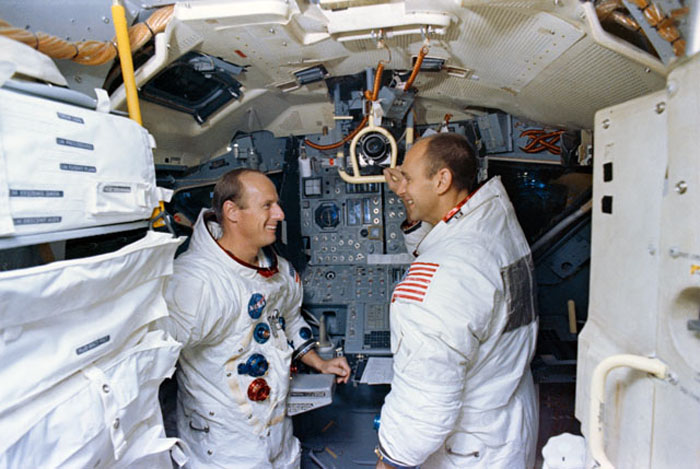
S69-56699 (22 Oct. 1969) --- Astronauts Charles Conrad Jr. (on left), commander; and Alan L. Bean, lunar module pilot, are shown in the Apollo Lunar Module Mission Simulator during simulator training at the Kennedy Space Center (KSC). Apollo 12 will be the National Aeronautics and Space Administration's (NASA) second lunar landing mission. The third Apollo 12 crew men will be astronaut Richard F. Gordon Jr., command module pilot.
.

S69-56596 (28 Oct. 1969) --- A nighttime, ground-level view of Pad A, Launch Complex 39, Kennedy Space Center (KSC) showing the Apollo 12 (Spacecraft 108/Lunar Module 6/Saturn 507) space vehicle, during the terminal phase of a Countdown Demonstration Test (CDDT). The crew of the National Aeronautics and Space Administration's (NASA) second lunar landing mission will be astronauts Charles Conrad Jr., commander; Richard F. Gordon Jr., command module pilot; and Alan L. Bean, lunar module pilot. The Apollo 12 launch has been scheduled for 11:22 a.m. (EST) on Nov. 14, 1969.
.
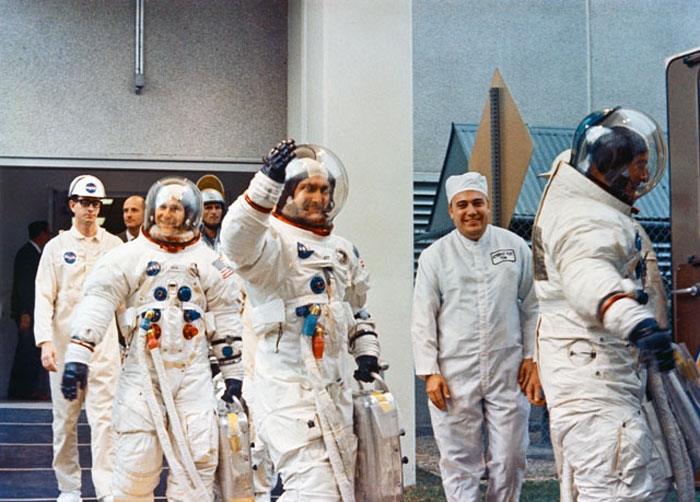
S69-58881 (14 Nov. 1969) --- The three Apollo 12 crew men leave the Kennedy Space Center's (KSC) Manned Spacecraft Operations Building (MSOB) during the Apollo 12 prelaunch countdown. Leading is astronaut Charles Conrad Jr., commander; followed by astronauts Richard F. Gordon Jr., command module pilot; and Alan L. Bean, lunar module pilot. They rode a special transport van over the Pad A, Launch Complex 39, where their spacecraft awaited. The Apollo 12 liftoff occurred at 11:22 a.m. (EST), Nov. 14, 1969. Apollo 12 is the United States' second lunar landing mission.
.

S69-58885 (14 Nov. 1969) --- Interior view of the White Room atop Pad A, Launch Complex 39, Kennedy Space Center (KSC), during the insertion of the Apollo 12 crew. In the center background preparing to ingress the spacecraft is astronaut Charles Conrad Jr., commander. Astronaut Alan L. Bean, lunar module pilot, stands in the right foreground. Awaiting his turn to ingress, but out of view, is astronaut Richard F. Gordon Jr., command module pilot. The Apollo 12 is the United States' second lunar landing mission.
.
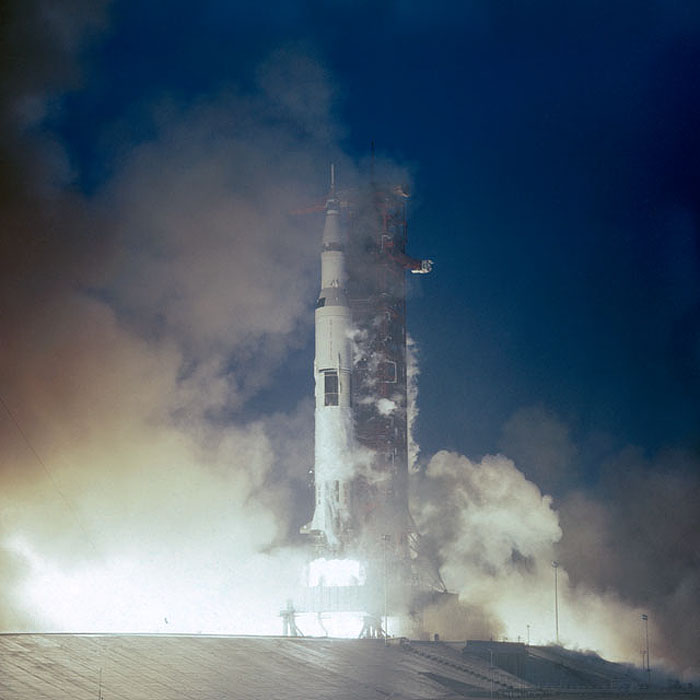
S69-58879 (14 Nov. 1969) --- The huge, 363-feet tall Apollo 12 (Spacecraft 108/Lunar Module 6/Saturn 507) space vehicle is launched from Pad A, Launch Complex 39, Kennedy Space Center (KSC), at 11:22 a.m. (EST), Nov. 14, 1969. Aboard the Apollo 12 spacecraft were astronauts Charles Conrad Jr., commander; Richard F. Gordon Jr., command module pilot, and Alan L. Bean, lunar module pilot. Apollo 12 is the United States' second lunar landing mission.
.
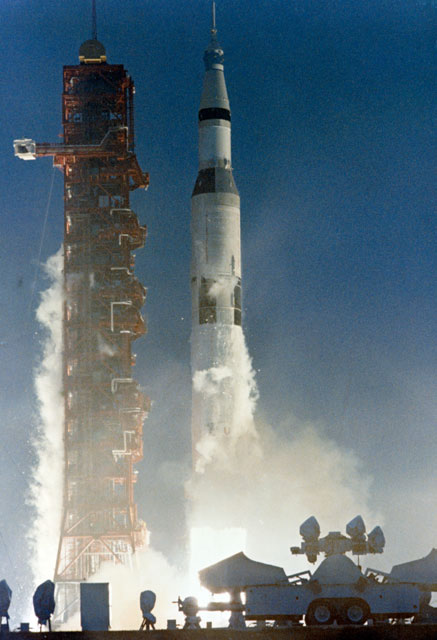
S69-58564 (14 Nov. 1969) --- The huge, 363-feet tall Apollo 12 (Spacecraft 108/Lunar Module 6/Saturn 507) space vehicle is launched from Pad A, Launch Complex 39, Kennedy Space Center (KSC), at 11:22 a.m. (EST), Nov. 14, 1969. Aboard the Apollo 12 spacecraft were astronauts Charles Conrad Jr., commander; Richard F. Gordon Jr., command module pilot; and Alan L. Bean, lunar module pilot. Apollo 12 is the United States' second lunar landing mission.
.
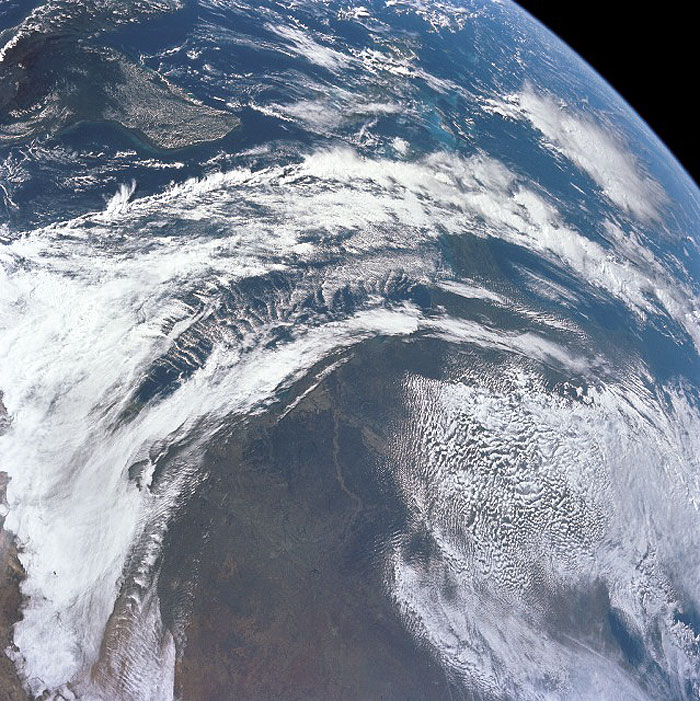
AS12-50-7325 (14 Nov. 1969) --- A view of Earth as photographed from the Apollo 12 spacecraft some three and a half hours after it lifted off on Nov. 14, 1969. Parts of the United States and Central America can be seen through the clouds. The area includes Texas, Lake Michigan, Florida and the Yucatan Peninsula.
.

AS12-50-7362 (14 Nov. 1969) --- A view of one-third of Earth, with Australia on the horizon, as photographed by the three-man crew of Apollo 12. The Command and Service Modules, mated to the Lunar Module (yet to be removed and transpositioned for landing) were en route to the moon for man's second mission there. Onboard the spacecraft were astronauts Charles Conrad Jr., Richard F. Gordon Jr. and Alan L. Bean.
.
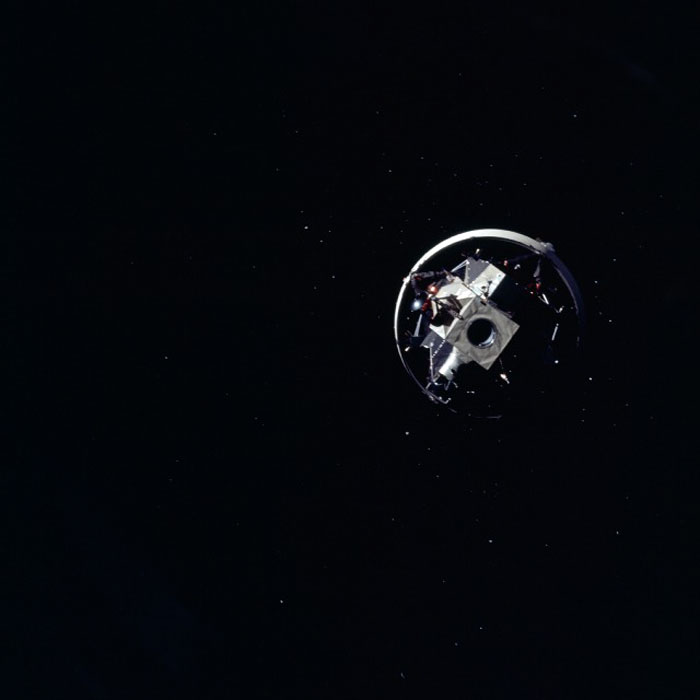
AS12-50-7328 (14 Nov. 1969) --- Apollo 12 Lunar Module (LM), still attached to the Saturn V third (S-IVB) stage, is pictured as seen from Apollo 12 Command and Service Modules (CSM) on the first day of the Apollo 12 lunar landing mission. This photograph was taken following CSM separation from LM/S-IVB and prior to Lunar Module extraction from the S-IVB stage. The Spacecraft Lunar Module Adapter (SLA) panels have already been jettisoned.
-
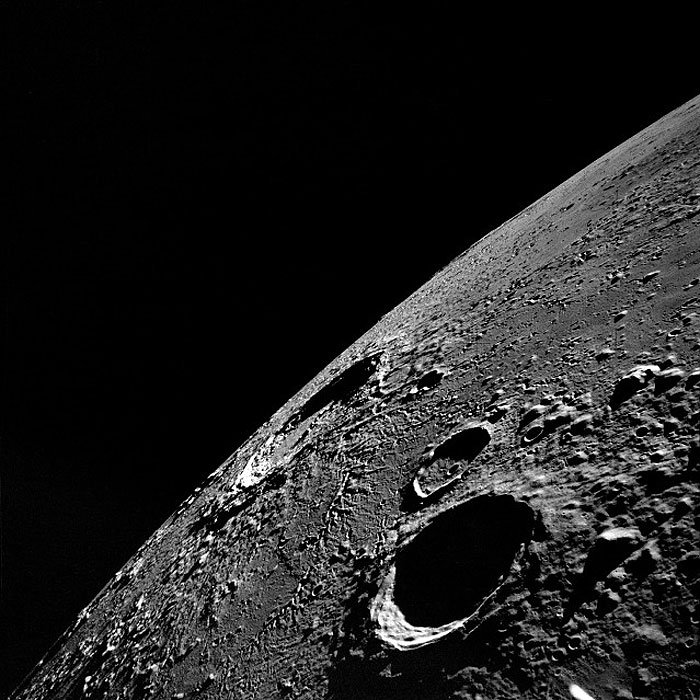
AS12-47-6876 (November 1969) --- An Apollo 12 high-oblique view of the lunar nearside looking northeast toward the crater Copernicus (in center near horizon), as photographed from lunar orbit. The shaded crater in the foreground is Reinhold. Reinhold B is the crater next to Reinhold which as the small crater in the center of it. Also, visible is the keyhole-shaped crater Fauth near the crater Copernicus.
.

AS12-47-6870 (November 1969) --- An Apollo 12 high-oblique view of the crater Tsiolkovsky (in center of horizon) on the lunar farside, as photographed from lunar orbit. The crew men of the Apollo 12 lunar landing mission were astronauts Charles Conrad Jr., commander; Richard F. Gordon Jr., command module pilot; and Alan L. Bean, lunar module pilot. Tsiolkovsky is centered at 128.5 degrees east longitude and 20.5 degrees south latitude. This view is looking south.
-
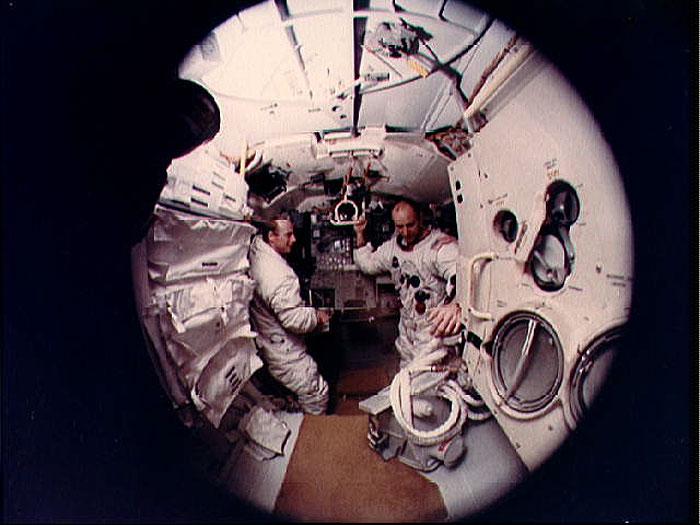
S69-56700 (22 Oct. 1969) --- A fish-eye lens view of astronauts Charles Conrad Jr. (on left), Apollo 12 commander, and Alan L. Bean, lunar module pilot, inside the Apollo Lunar Module Mission Simulator during simulator training at the Kennedy Space Center (KSC). Apollo 12 will be the National Aeronautics and Space Administration's (NASA) second lunar landing mission. The third Apollo 12 crewmember will be astronaut Richard F. Gordon Jr., command module pilot.
.
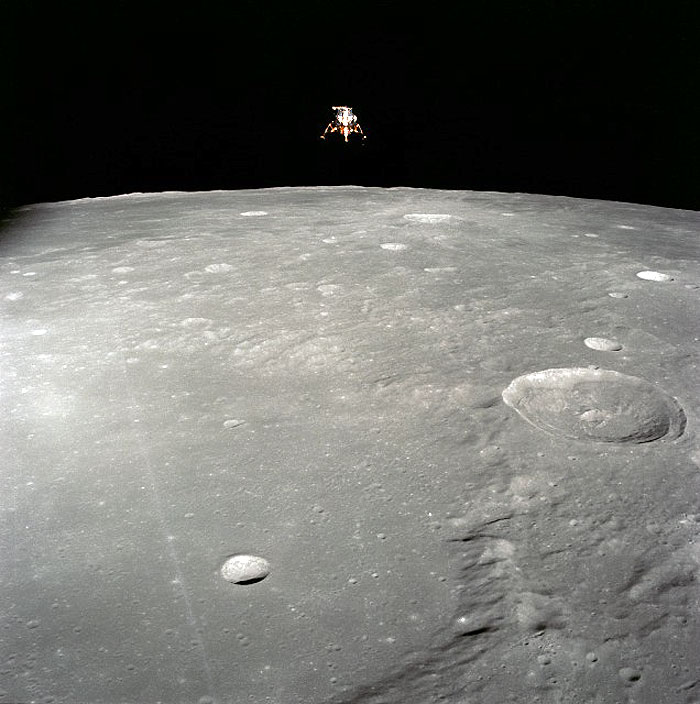
AS12-51-7507 (14-24 Nov. 1969) --- The Apollo 12 Lunar Module (LM), in a lunar landing configuration, is photographed in lunar orbit from the Command and Service Modules (CSM). The coordinates of the center of the lunar surface shown in picture are 4.5 degrees west longitude and 7 degrees south latitude. The largest crater in the foreground is Ptolemaeus; and the second largest is Herschel. Aboard the LM were astronauts Charles Conrad Jr., commander; and Alan L. Bean, lunar module pilot. Astronaut Richard R. Gordon Jr., command module pilot, remained with the CSM in lunar orbit while Conrad and Bean descended in the LM to explore the surface of the moon.
-

AS12-46-6726 (19 Nov. 1969) --- Astronaut Alan L. Bean, lunar module pilot for the Apollo 12 mission, starts down the ladder of the Lunar Module (LM) to join astronaut Charles Conrad Jr., mission commander, in extravehicular activity (EVA). While astronauts Conrad and Bean descended in the LM "Intrepid" to explore the Ocean of Storms region of the moon, astronaut Richard F. Gordon Jr., command module pilot, remained with the Command and Service Modules (CSM) "Yankee Clipper" in lunar orbit.
.
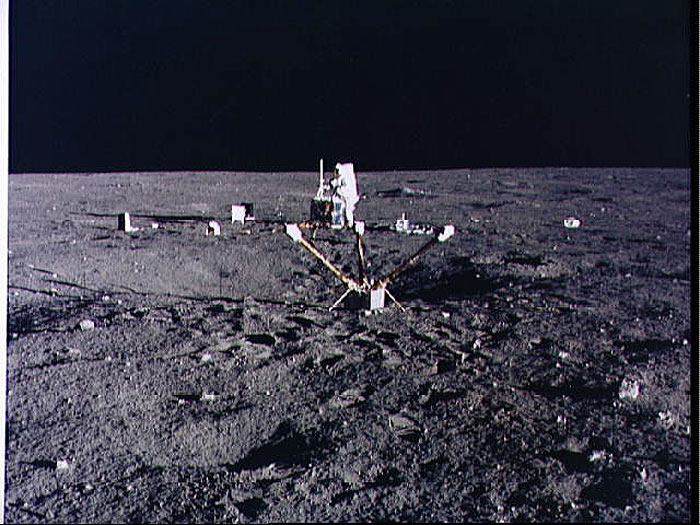
AS12-47-6921 (19 Nov. 1969) --- Astronaut Charles Conrad Jr., commander of the Apollo 12 lunar landing mission, aligns the antenna on the Central Station of the Apollo Lunar Surface Experiments Package (ALSEP) during the first Apollo 12 extravehicular activity (EVA). This photograph was taken by astronaut Alan L. Bean, lunar module pilot. The ALSEP's Lunar Surface Magnetometer (LSM) is in the foreground. In the center background near Conrad are other components of ALSEP. Astronaut Richard F. Gordon Jr., command module pilot, remained with the Apollo 12 Command and Service Module (CSM) in lunar orbit while Conrad and Bean descended to explore the moon.
.
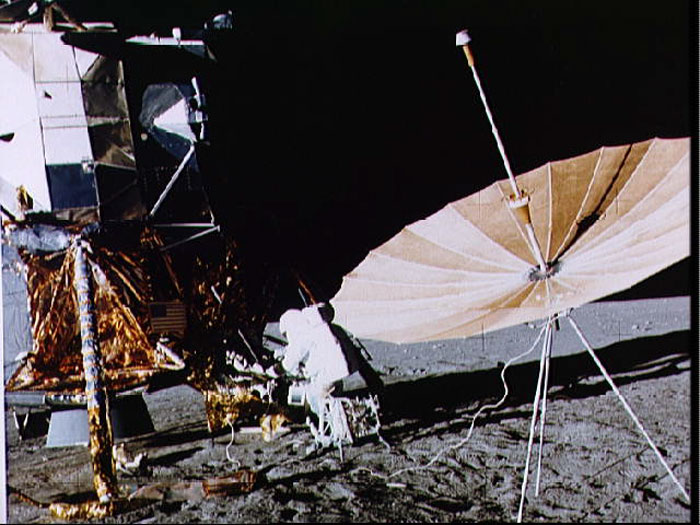
AS12-47-6988 (19 Nov. 1969) --- Astronaut Charles Conrad Jr., commander of the Apollo 12 lunar landing mission, stands at the Module Equipment Stowage Assembly (MESA) on the Lunar Module (LM) following the first Apollo 12 extravehicular activity (EVA) on the lunar surface. The erectable S-band antenna is already deployed at right. The carrier for the Apollo Lunar Hand Tools (ALHT) is near Conrad. While astronauts Conrad and Alan L. Bean, lunar module pilot, descended in the LM to explore the lunar surface, astronaut Richard F. Gordon Jr., command module pilot, remained with the Command and Service Modules (CSM) in lunar orbit.
.
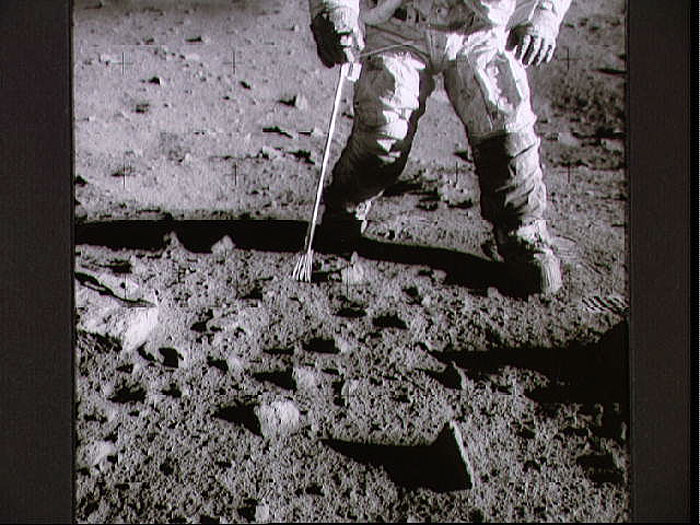
AS12-48-7149 (20 Nov. 1969) --- A close-up view of astronaut Charles Conrad Jr., commander of the Apollo 12 lunar landing mission, photographed during the extravehicular activity (EVA) on the surface of the moon. An EVA checklist is on Conrad's left wrist. A set of tongs, an Apollo Lunar Hand Tool (ALHT), is held in his right hand. Several footprints can be seen. Astronaut Richard F. Gordon Jr., command module pilot, remained with the Command and Service Modules (CSM) in lunar orbit while astronauts Conrad and Alan L. Bean, lunar module pilot, descended in the LM to explore the moon. Note lunar soil on the suit of Conrad, especially around the knees and below.
.

AS12-47-6897 (19 Nov. 1969) --- Astronaut Charles Conrad Jr., Apollo 12 commander, stands beside the United States flag after it was unfurled on the lunar surface during the first extravehicular activity (EVA), on Nov. 19, 1969. Several footprints made by the crewmembers can be seen in the photograph. While astronauts Conrad and Alan L. Bean, lunar module pilot, descended in the Lunar Module (LM) "Intrepid" to explore the Ocean of Storms region of the moon, astronaut Richard F. Gordon Jr., command module pilot, remained with the Command and Service Modules (CSM) "Yankee Clipper" in lunar orbit.
.
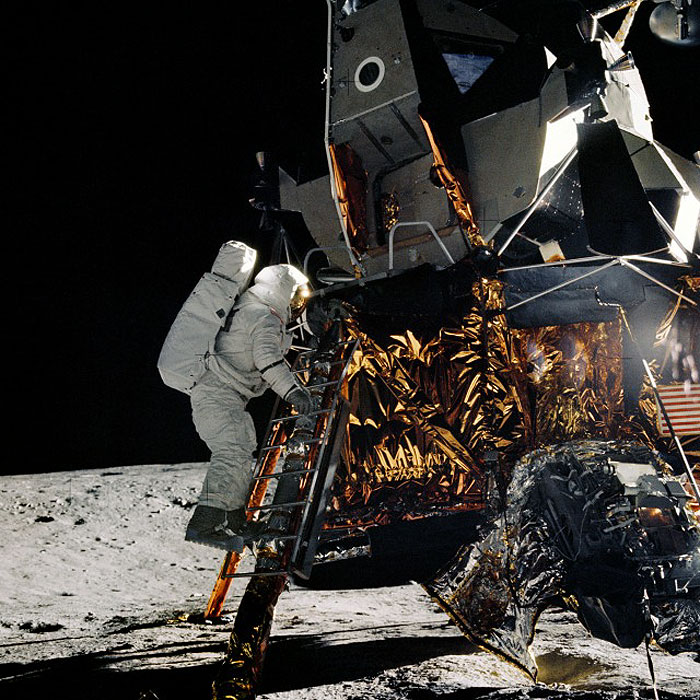
AS12-46-6728 (19 Nov. 1969) --- Astronaut Alan L. Bean, lunar module pilot for the Apollo 12 mission, is about to step off the ladder of the Lunar Module to join astronaut Charles Conrad Jr., mission commander, in extravehicular activity (EVA). Conrad and Bean descended in the Apollo 12 LM to explore the moon while astronaut Richard F. Gordon Jr., command module pilot, remained with the Command and Service Modules in lunar orbit.
.
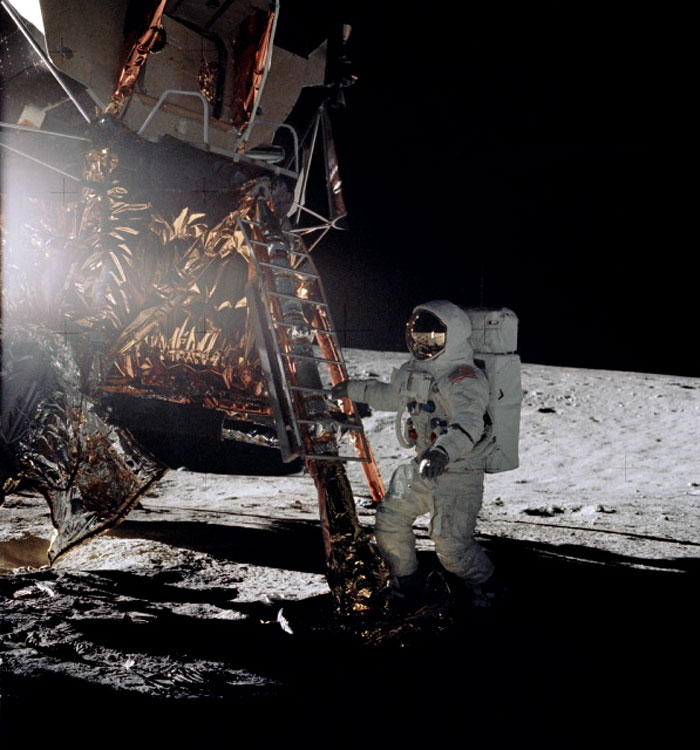
AS12-46-6729 (19 Nov. 1969) --- Astronaut Alan L. Bean, lunar module pilot for the Apollo 12 lunar landing mission, steps from the ladder of the Lunar Module to join astronaut Charles Conrad Jr., commander, in extravehicular activity on Nov. 19, 1969. Astronaut Richard F. Gordon Jr., command module pilot, remained with the Command and Service Modules in lunar orbit
.
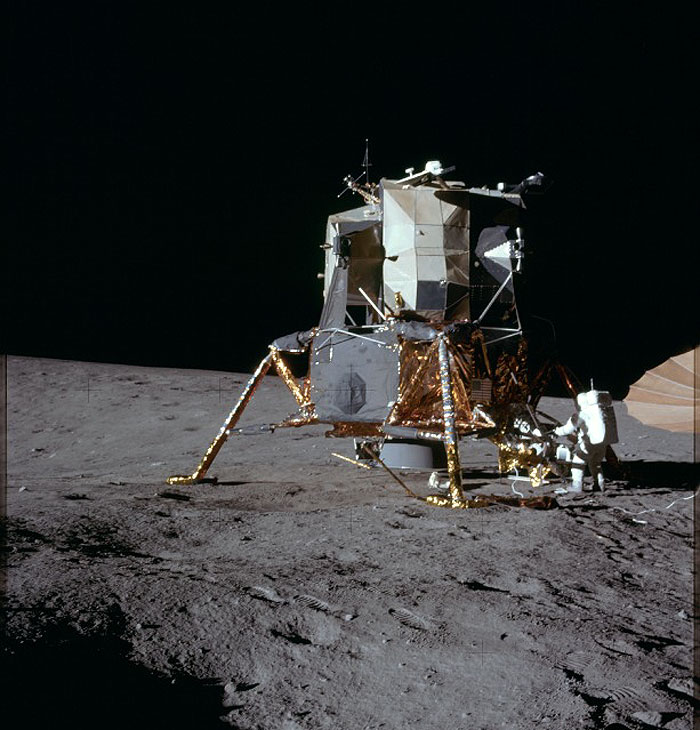
AS12-46-6749 (19 Nov. 1969) --- Astronaut Alan L. Bean, lunar module pilot for the Apollo 12 lunar landing mission, works at the Modular Equipment Stowage Assembly (MESA) on the Apollo 12 Lunar Module (LM) during the mission's first extravehicular activity, (EVA) on Nov. 19, 1969. Astronaut Charles Conrad Jr., commander, and Bean descended in the Apollo 12 LM to explore the moon while astronaut Richard F. Gordon Jr., command module pilot, remained with the Command and Service Modules (CSM) in lunar orbit.
-
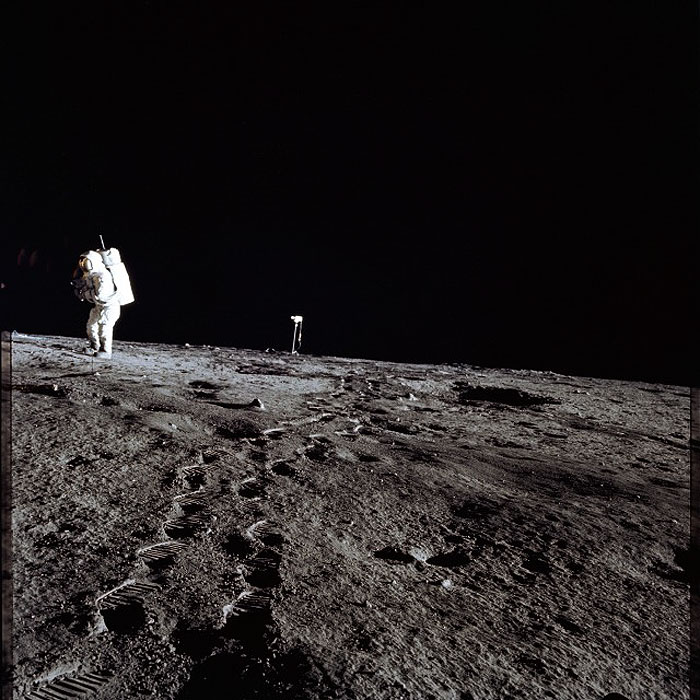
AS12-46-6780 (19 Nov. 1969) --- Astronaut Alan L. Bean, lunar module pilot for the Apollo 12 lunar landing mission, walks from the color lunar surface television camera (center) toward the Apollo 12 Lunar Module (LM - out of frame). The photograph was taken by astronaut Charles Conrad Jr., commander, during the first extravehicular activity (EVA) of the mission. While astronauts Conrad and Bean descended in the LM "Intrepid" to explore the Ocean of Storms region of the moon, astronaut Richard F. Gordon Jr., command module pilot, remained with the Command and Service Modules (CSM) "Yankee Clipper" in lunar orbit.
.
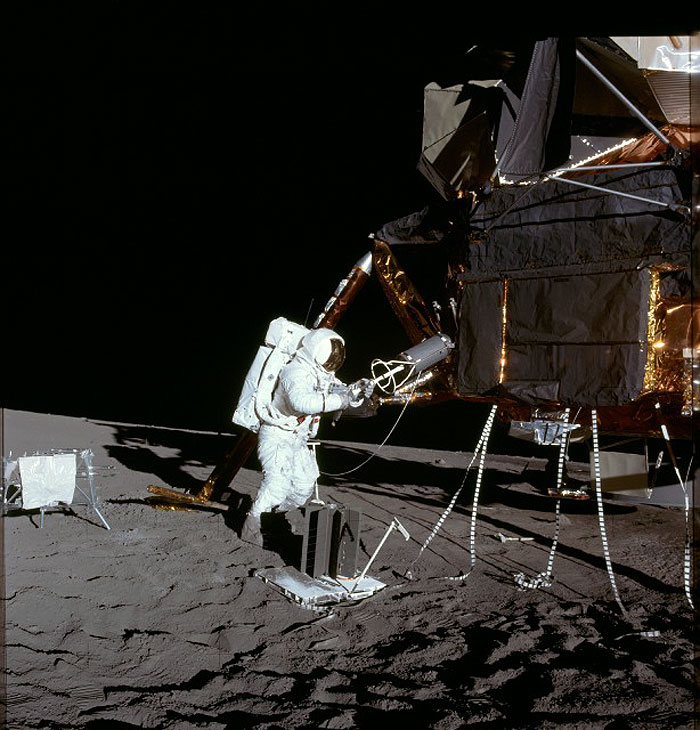
AS12-46-6790 (19 Nov. 1969) --- Astronaut Alan L. Bean, lunar module pilot, is photographed at quadrant II of the Lunar Module (LM) during the first Apollo 12 extravehicular activity (EVA) on the moon. This picture was taken by astronaut Charles Conrad Jr., commander. Here, Bean is using a fuel transfer tool to remove the fuel element from the fuel cask mounted on the LM's descent stage. The fuel element was then placed in the Radioisotope Thermoelectric Generator (RTG), the power source for the Apollo Lunar Surface Experiments Package (ALSEP) which was deployed on the moon by the two astronauts. The RTG is next to Bean's right leg. While astronauts Conrad and Bean descended in the LM "Intrepid" to explore the Ocean of Storms region of the moon, astronaut Richard F. Gordon Jr., command module pilot, remained with the Command and Service Modules (CSM) "Yankee Clipper" in lunar orbit.
.
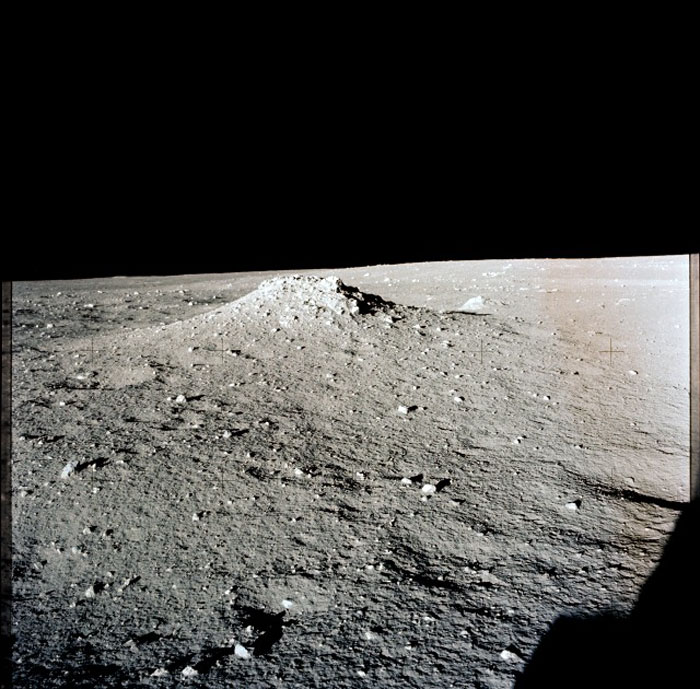
AS12-46-6795 (19-20 Nov. 1969) --- A view of the lunar surface in the vicinity of the Apollo 12 lunar landing site, photographed during the extravehicular activity (EVA) of astronauts Charles Conrad Jr., commander, and Alan L. Bean, lunar module pilot. Conrad and Bean encountered the odd, anthill-shaped mound during their lunar traverse. The two descended in the Apollo 12 Lunar Module (LM) to explore the moon, while astronaut Richard F. Gordon Jr., command module pilot, remained with the Command and Service Modules (CSM) in lunar orbit.
.
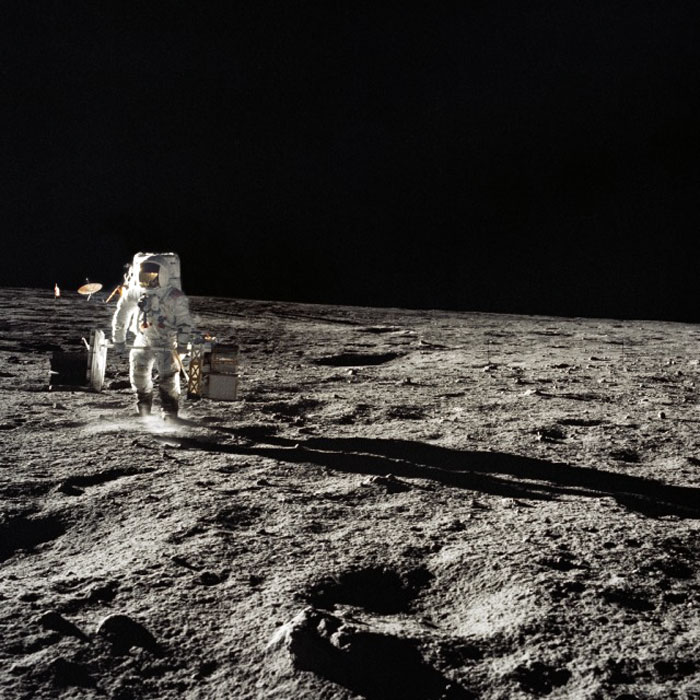
AS12-46-6807 (19 Nov. 1969) --- Astronaut Alan L. Bean, lunar module pilot, traverses with the two sub packages of the Apollo Lunar Surface Experiments Package (ALSEP) during the first Apollo 12 extravehicular activity (EVA). Bean deployed the ALSEP components 300 feet from the Lunar Module (LM). The LM and deployed erectable S-band antenna can be seen in the background.
-
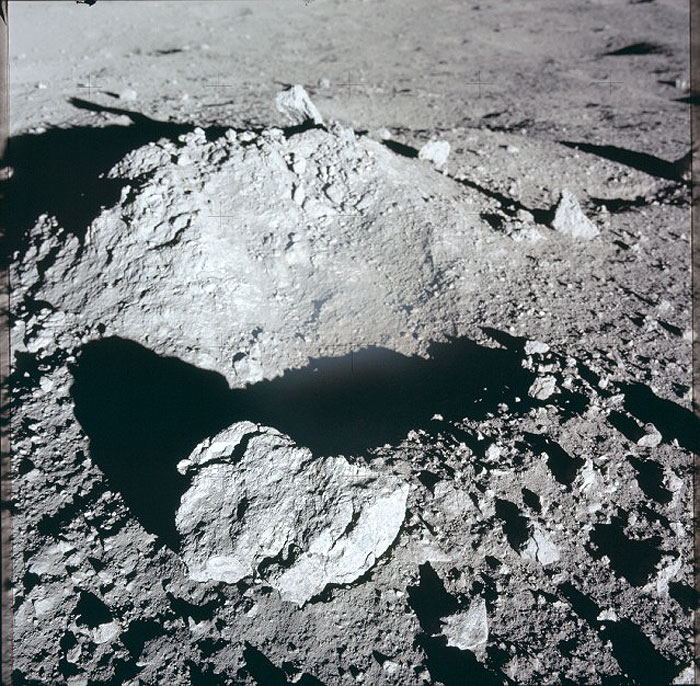
AS12-46-6825 (19 Nov. 1969) --- Close-up view of a lunar rock, small crater, and lunar mound as photographed during the Apollo 12 extravehicular activity (EVA). Astronaut Richard F. Gordon Jr., command module pilot, remained with the Apollo 12 Command and Service Modules (CSM) in lunar orbit while astronauts Charles Conrad Jr., commander, and Alan L. Bean, lunar module pilot, descended in the Lunar Module (LM) to explore the moon.
-
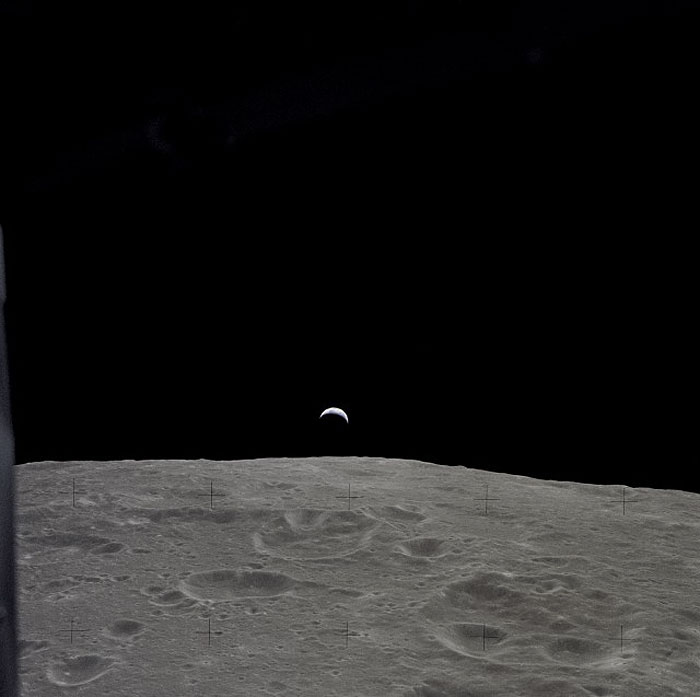
AS12-47-6891 (14-24 Nov. 1969) --- A partially illuminated Earth rises above the lunar horizon in this photograph taken from the Apollo 12 spacecraft in lunar orbit.
.
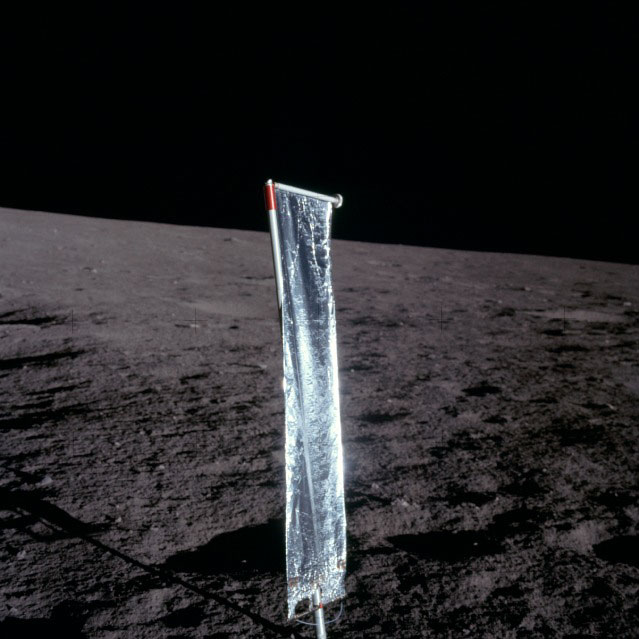
AS12-47-6898 (19 Nov. 1969) --- A close-up view of the Solar Wind Composition device. Astronaut Alan L. Bean, lunar module pilot, took this photograph, after having deployed the device. Astronauts Charles Conrad Jr., commander, and Bean descended in the Apollo 12 Lunar Module (LM) to explore the moon, while astronaut Richard F. Gordon Jr., command module pilot, remained in lunar orbit with the Command and Service Modules (CSM).
-
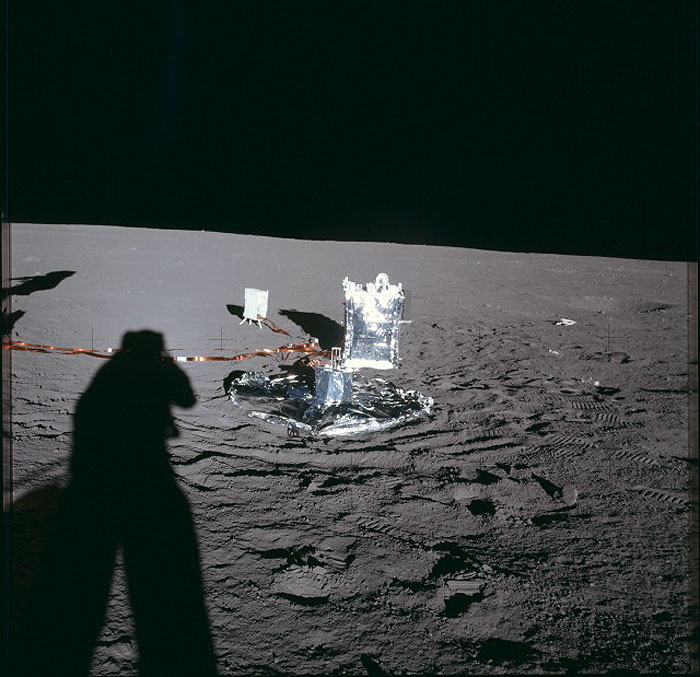
AS12-47-6918 (19 Nov. 1969) --- Astronaut Alan L. Bean, lunar module pilot, took this photograph of three of the components of the Apollo Lunar Surface Experiments Package (ALSEP) which was deployed on the moon during the first Apollo 12 extravehicular activity (EVA). The Passive Seismic Experiment (PSE) is in the center foreground. The largest object is the Central Station; and the white object on legs is the Suprathermal Ion Detector Experiment (SIDE). A portion of the shadow of astronaut Charles Conrad Jr., commander, can be seen at the left center edge of the picture. Astronaut Richard F. Gordon Jr., command module pilot, remained with the Apollo 12 Command and Service Modules (CSM) in lunar orbit while Conrad and Bean descended in the Lunar Module (LM) to explore the moon.
.
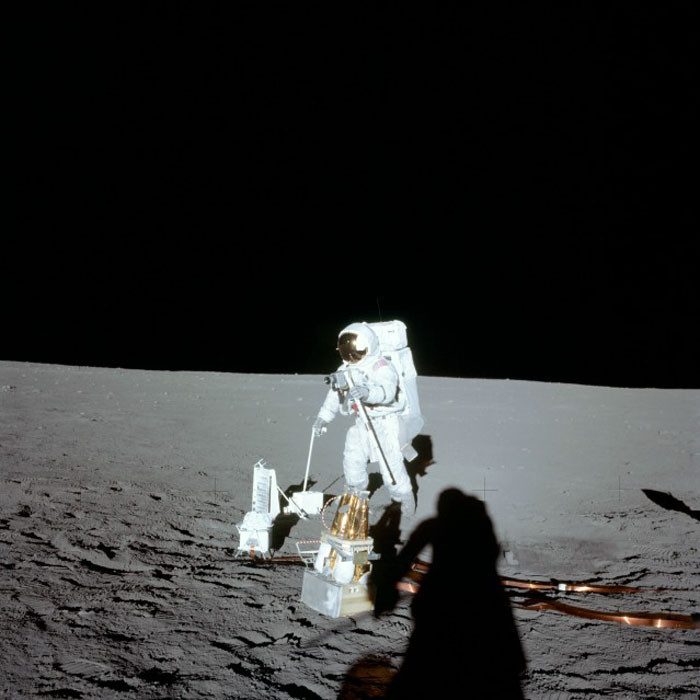
AS12-47-6919 (19 Nov. 1969) --- Astronaut Alan L. Bean, lunar module pilot, deploys components of the Apollo Lunar Surface Experiments Package (ALSEP) during the first Apollo 12 extravehicular activity (EVA) on the moon. The photo was made by astronaut Charles Conrad Jr., commander, using a 70mm handheld Hasselblad camera modified for lunar surface usage.
.

AS12-47-6949 (19-20 Nov. 1969) --- A photograph of the Apollo 12 lunar landing site taken during the extravehicular activity (EVA) of astronauts Charles Conrad Jr., commander; and Alan L. Bean, lunar module pilot. The Apollo 12 Lunar Module (LM) is on the left. Barely visible in the center of the picture, in the shadows on the farside of the crater, is the Surveyor 3 spacecraft. The two spacecraft are about 600 feet apart. Conrad and Bean walked over to Surveyor 3 during their second EVA. The television camera and several other pieces were taken from Surveyor 3 and brought back to Earth for scientific examination. Astronaut Richard F. Gordon Jr., command module pilot, remained with the Command and Service Modules (CSM) in lunar orbit, while astronauts Conrad and Bean descended in the LM to explore the moon. The considerable glare in the picture is caused by the position of the sun. The Apollo tool carrier is the object next to the LM footpad.
.
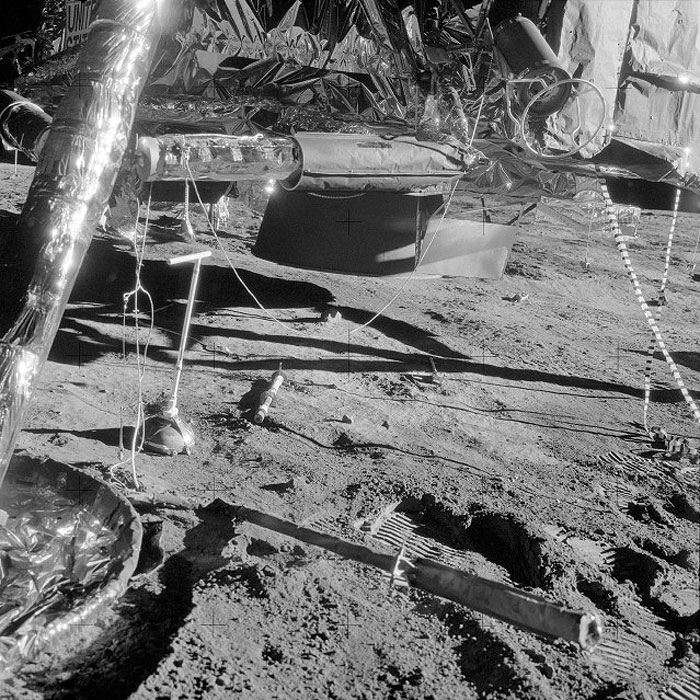
AS12-48-7034 (19 Nov. 1969) --- A close-up view of a portion of quadrant II of the descent stage of the Apollo 12 Lunar Module (LM), photographed during the Apollo 12 extravehicular activity (EVA). At lower left is the LM's Y footpad. The empty Radioisotope Thermoelectric Generator (RTG) fuel cask is at upper right. The fuel capsule has already been removed and placed in the RTG. The RTG furnishes power for the Apollo Lunar Surface Experiments Package (ALSEP) which the Apollo 12 astronauts deployed on the moon. The LM's descent engine skirt is in the center background. The rod-like object protruding out from under the footpad is a lunar surface sensing probe. Astronaut Richard F. Gordon Jr., command module pilot, remained with the Command and Service Modules (CSM) in lunar orbit while astronauts Charles Conrad Jr., commander; and Alan L. Bean, lunar module pilot, descended in the LM to explore the moon.
.
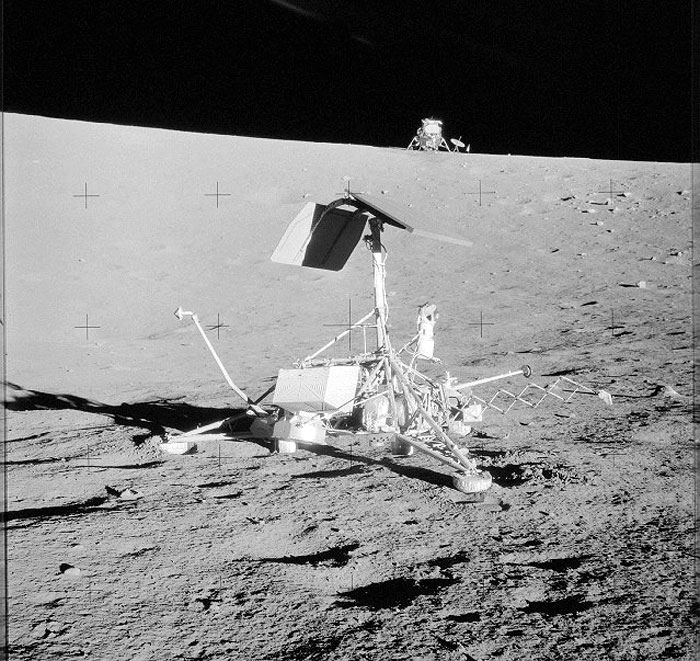
AS12-48-7099 (20 Nov. 1969) --- This unusual view shows two National Aeronautics and Space Administration (NASA) spacecraft on the surface of the moon. In the center foreground is the unmanned Surveyor 3 spacecraft, which soft landed on the lunar surface on April 19, 1967. Just 600 feet away from the Surveyor 3 spacecraft, pictured here in the background, is the Apollo 12 Lunar Module (LM), which landed on the lunar surface on Nov. 19, 1969. This photograph was taken the following day, during the second Apollo 12 extravehicular activity (EVA) in which astronauts Charles Conrad Jr., commander, and Alan L. Bean, lunar module pilot, participated. Pictured to the right of the LM are the deployed S-Band antenna and the United States flag, which was unfurled on Nov. 19, 1969. While Conrad and Bean descended from lunar orbit in their Apollo 12 LM, astronaut Richard F. Gordon Jr., command module pilot, remained with the Command and Service Modules (CSM).
.
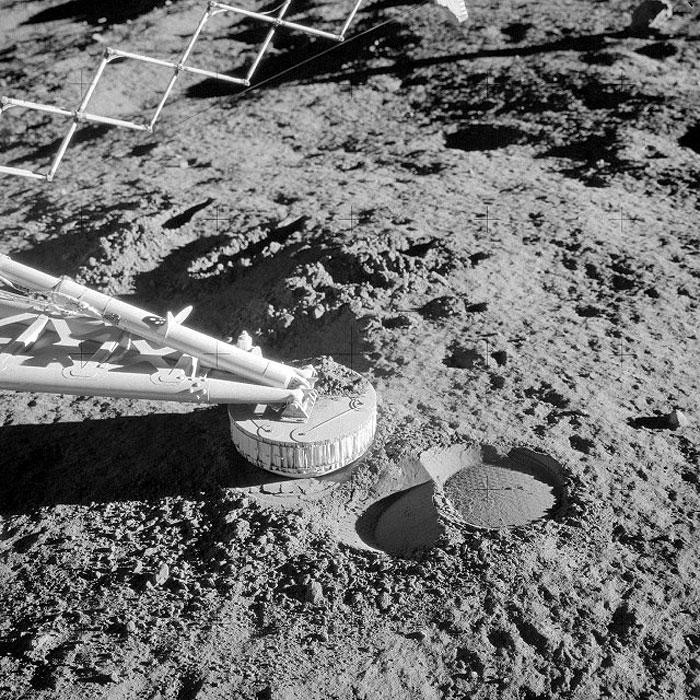
AS12-48-7110 (20 Nov. 1969) --- A close-up view of a footpad and surface sampler with scoop (arm, out of frame) on the Surveyor 3 spacecraft which was photographed by the Apollo 12 astronauts during their second extravehicular activity (EVA) on the moon. The Apollo 12 Lunar Module (LM), with astronauts Charles Conrad Jr. and Alan L. Bean aboard, touched down in the Ocean of Storms only 600 feet from Surveyor 3. The television camera and several other pieces were taken from Surveyor 3 and brought back to Earth for scientific examination. The unmanned spacecraft soft-landed on the moon on April 19, 1967. Note the imprint in the lunar soil which was caused when the Surveyor 3 bounced upon landing.
-
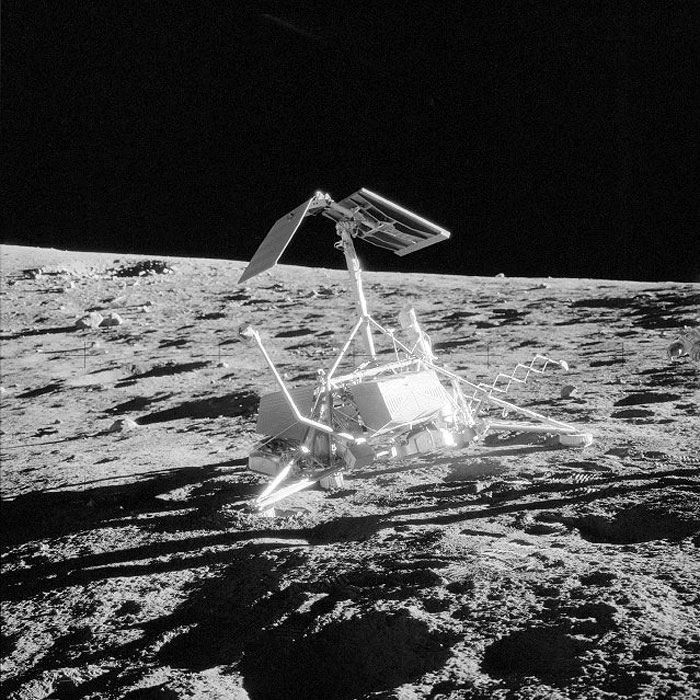
AS12-48-7121 (20 Nov. 1969) --- An excellent view of the unmanned Surveyor 3 spacecraft which was photographed during the Apollo 12 second extravehicular activity (EVA) on the surface of the moon. The Apollo 12 Lunar Module (LM), with astronauts Charles Conrad Jr., commander, and Alan L. Bean, lunar module pilot, aboard landed within 600 feet of Surveyor 3 in the Ocean of Storms. The television camera and several other pieces were taken from Surveyor 3 and brought back to Earth for scientific examination. Surveyor 3 landed on the side of this small crater in the Ocean of Storms on April 19, 1967. Astronaut Richard F. Gordon Jr., command module pilot, remained with the Apollo 12 Command and Service Modules (CSM) in lunar orbit while Conrad and Bean descended to explore the moon.
.
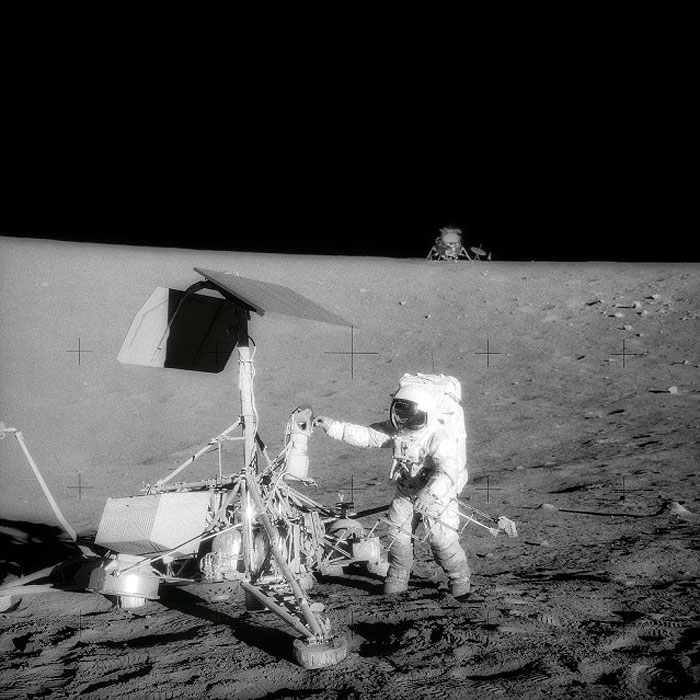
AS12-48-7133 (20 Nov. 1969) --- This unusual photograph, taken during the second Apollo 12 extravehicular activity (EVA), shows two U.S. spacecraft on the surface of the moon. The Apollo 12 Lunar Module (LM) is in the background. The unmanned Surveyor 3 spacecraft is in the foreground. The Apollo 12 LM, with astronauts Charles Conrad Jr. and Alan L. Bean aboard, landed about 600 feet from Surveyor 3 in the Ocean of Storms. The television camera and several other pieces were taken from Surveyor 3 and brought back to Earth for scientific examination. Here, Conrad examines the Surveyor's TV camera prior to detaching it. Astronaut Richard F. Gordon Jr. remained with the Apollo 12 Command and Service Modules (CSM) in lunar orbit while Conrad and Bean descended in the LM to explore the moon. Surveyor 3 soft-landed on the moon on April 19, 1967.
.
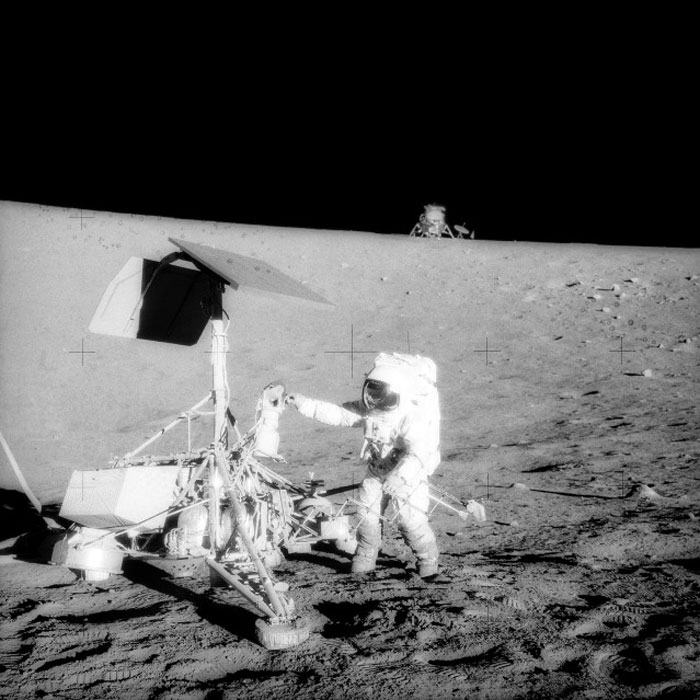
AS12-48-7134 (20 Nov. 1969) --- This unusual photograph, taken during the second Apollo 12 extravehicular activity (EVA), shows two U.S. spacecraft on the surface of the moon. The Apollo 12 Lunar Module (LM) is in the background. The unmanned Surveyor 3 spacecraft is in the foreground. The Apollo 12 LM, with astronauts Charles Conrad Jr. and Alan L. Bean aboard, landed about 600 feet from Surveyor 3 in the Ocean of Storms. The television camera and several other pieces were taken from Surveyor 3 and brought back to Earth for scientific examination. Here, Conrad examines the Surveyor's TV camera prior to detaching it. Astronaut Richard F. Gordon Jr. remained with the Apollo 12 Command and Service Modules (CSM) in lunar orbit while Conrad and Bean descended in the LM to explore the moon. Surveyor 3 soft-landed on the moon on April 19, 1967.
.
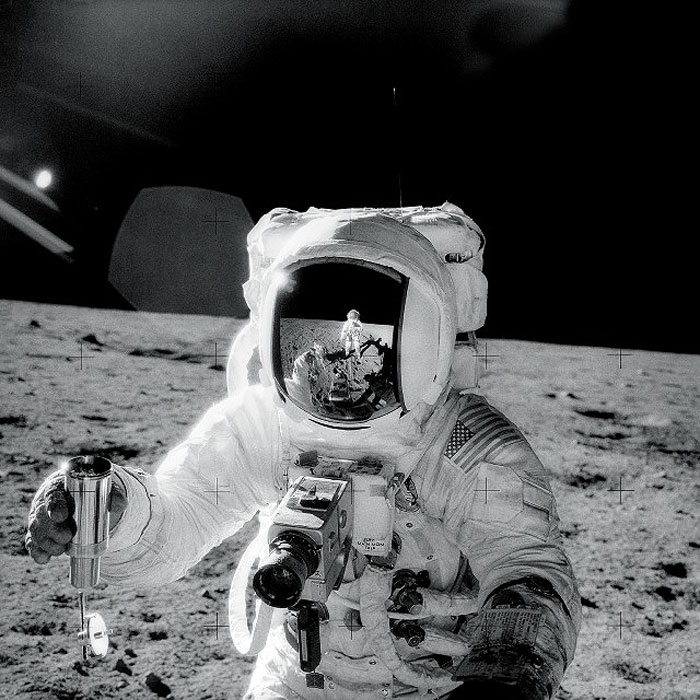
AS12-49-7278 (19-20 Nov. 1969) --- Astronaut Alan L. Bean holds a Special Environmental Sample Container filled with lunar soil collected during the extravehicular activity (EVA) in which astronauts Charles Conrad Jr., commander, and Bean, lunar module pilot, participated. Conrad, who took this picture, is reflected in Bean's helmet visor. Conrad and Bean descended in the Apollo 12 Lunar Module (LM) to explore the lunar surface while astronaut Richard F. Gordon Jr., command module pilot, remained with the Command and Service Modules (CSM) in lunar orbit.
.
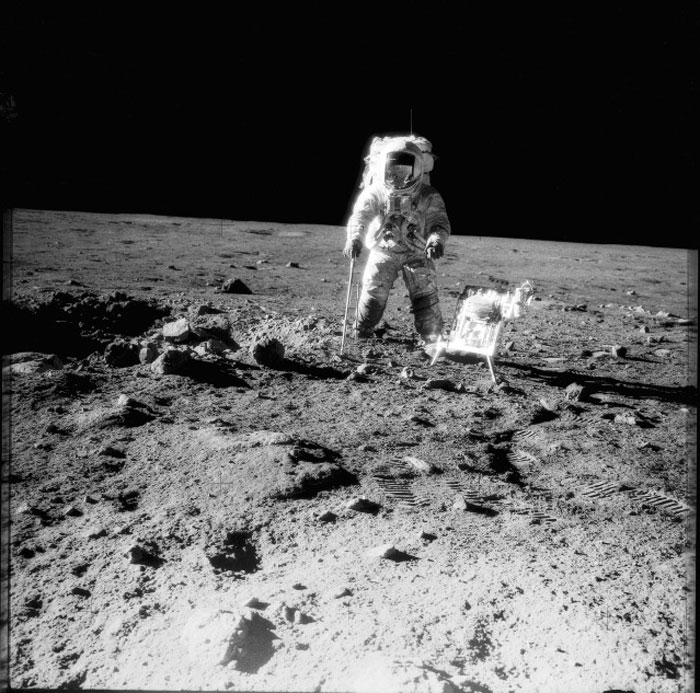
AS12-49-7318 (19-20 Nov. 1969) --- One of the Apollo 12 crew members is photographed with the tools and carrier of the Apollo Lunar Hand Tools (ALHT) during extravehicular activity (EVA) on the surface of the moon. Several footprints made by the two crew members during their EVA are seen in the foreground. While astronauts Charles Conrad Jr., commander, and Alan L. Bean, lunar module pilot, descended in the Lunar Module (LM) "Intrepid" to explore the Ocean of Storms region of the moon, astronaut Richard F. Gordon Jr., command module pilot, remained with the Command and Service Modules (CSM) "Yankee Clipper" in lunar orbit.
.
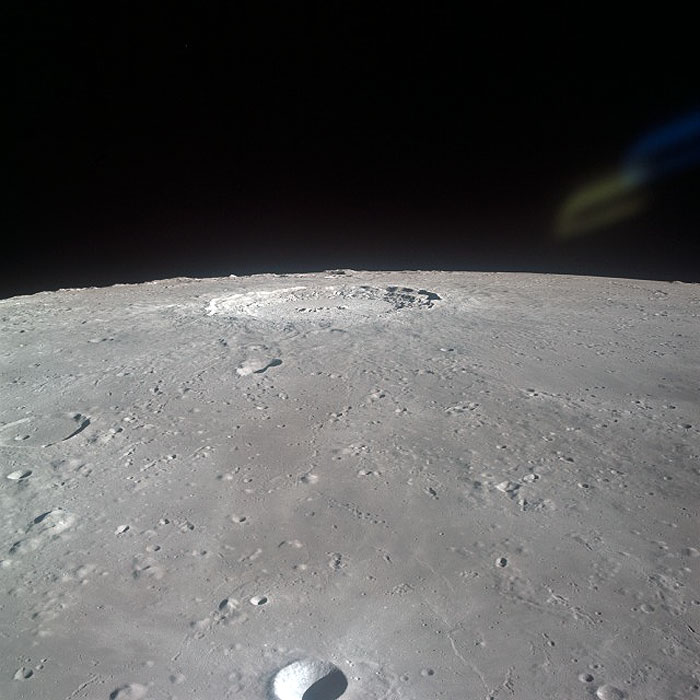
AS12-51-7541 (November 1969) --- An oblique view of the larger crater Copernicus on the lunar near side, as photographed from the Apollo 12 spacecraft in lunar orbit. The coordinates of the center of Copernicus are approximately 20 degrees west longitude and 9.5 degrees north latitude. Note the key-shaped Fauth and Fauth A crater located directly south of Copernicus. This view is looking generally north-northwest. An 80mm focal length lens was used to take this picture.
-
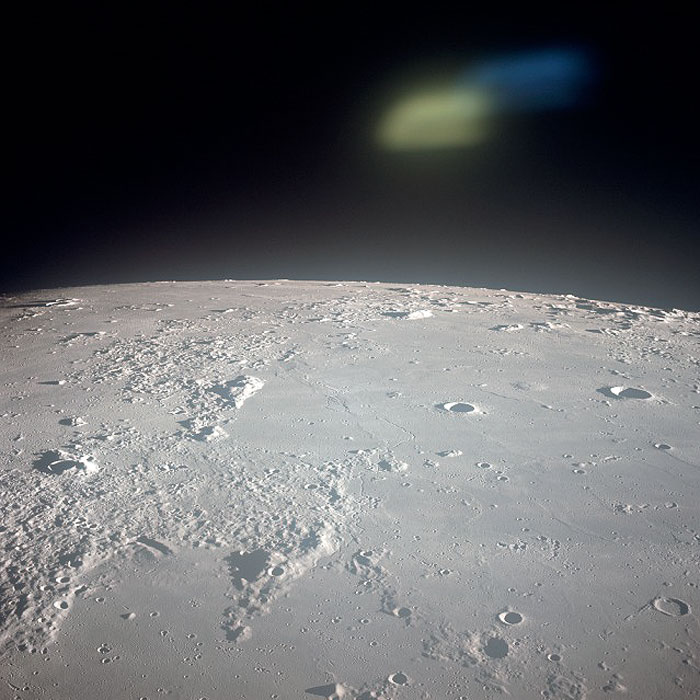
AS12-51-7552 (November 1969) --- A high oblique view of the moon, looking northwest over the Ocean of Storms (right) and the more rugged area around the crater Kepler A (out of view at left). The distinct crater in the mare at right center is Milichius A. The center of the terrain pictured is located at 11 degrees north latitude and 32.5 degrees west longitude. While astronauts Charles Conrad Jr., commander, and Alan L. Bean, lunar module pilot, descended in the Lunar Module (LM) "Intrepid" to explore the Ocean of Storms region of the moon, astronaut Richard F. Gordon Jr., command module pilot, remained with the Command and Service Modules (CSM) "Yankee Clipper" in lunar orbit.
.
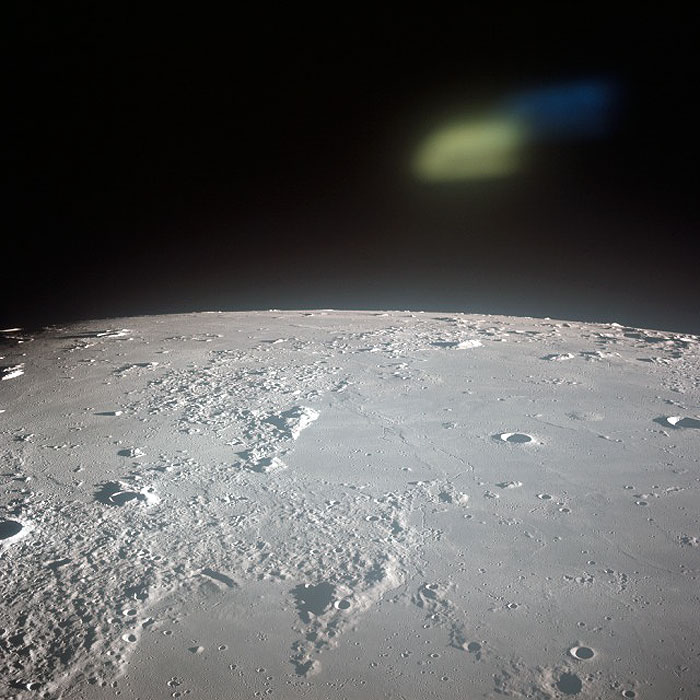
AS12-51-7553 (November 1969) --- A high oblique view, photographed from the Apollo 12 spacecraft, looking northwest over the Ocean of Storms (right) and the more rugged area around the crater Kepler A (partially seen at extreme left). The distinct crater in the mare at right center is Milichius A. Coordinates of the center of the terrain pictured are 34 degrees west longitude and 12 degrees north latitude.
.
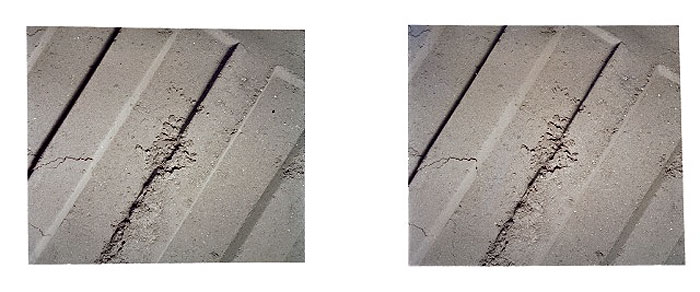
AS12-57-8448 (19-20 Nov. 1969) --- An Apollo 12 stereo view showing a three-inch square of the lunar surface upon which an astronaut had stepped. Taken during extravehicular activity of astronauts Charles Conrad Jr. and Alan L. Bean, the exposure of the boot imprint was made with an Apollo 35mm stereo close-up camera. The camera was developed to get the highest possible resolution of a small area. The three-inch square is photographed with a flash illumination and at a fixed distance. The camera is mounted on a walking stick, and the astronauts use it by holding it up against the object to be photographed and pulling the trigger. While astronauts Conrad and Bean descended in their Apollo 12 Lunar Module to explore the lunar surface, astronaut Richard F. Gordon Jr. remained with the Command and Service Modules in lunar orbit.
.
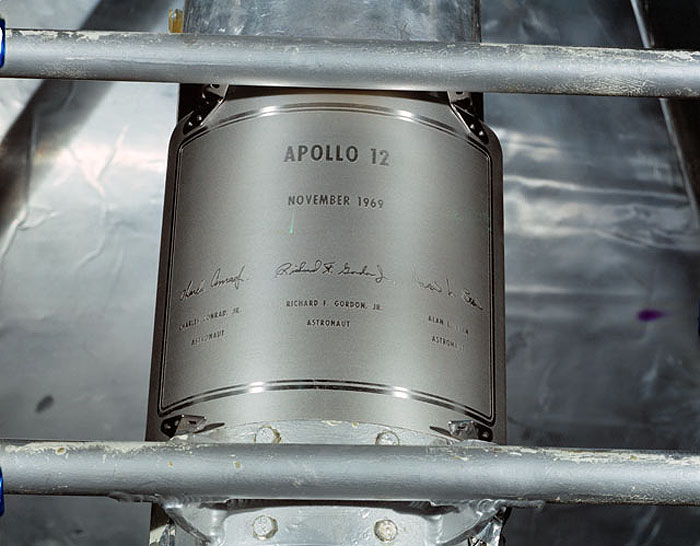
S69-53326 (November 1969) --- Close-up view of a replica of the plaque which the Apollo 12 astronauts will leave on the moon in commemoration of their flight. The plaque will be attached to the ladder on the landing gear strut on the descent stage of the Apollo 12 Lunar Module (LM). Apollo 12 will be the United States' second lunar landing mission.
-

S69-59525 (19 Nov. 1969) --- Overall view of activity in the Mission Operations Control Room (MOCR) in the Mission Control Center (MCC), Building 30, during the Apollo 12 lunar landing mission. When this picture was made the first Apollo 12 extravehicular activity (EVA) was being televised from the surface of the moon.
.
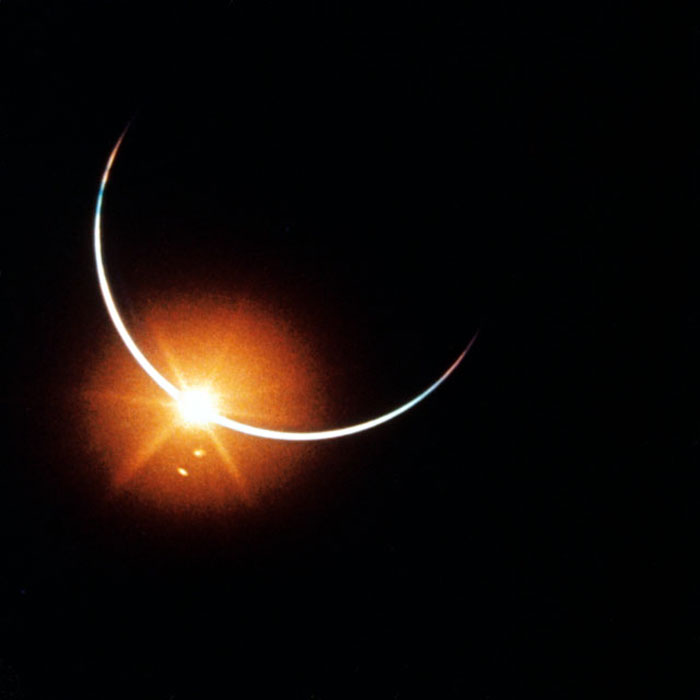
S80-37406 (14-24 Nov. 1969) --- This photograph of the eclipse of the sun was taken with a 16mm motion picture camera from the Apollo 12 spacecraft during its trans-Earth journey home from the moon. The fascinating view was created when the Earth moved directly between the sun and the Apollo 12 spacecraft. Aboard Apollo 12 were astronauts Charles Conrad Jr., commander; Richard F. Gordon Jr., command module pilot; and Alan L. Bean, lunar module pilot. While astronauts Conrad and Bean descended in the Lunar Module (LM) "Intrepid" to explore the Ocean of Storms region of the moon, astronaut Gordon remained with the Command and Service Modules (CSM) "Yankee Clipper" in lunar orbit.
.

S69-22728 (24 Nov. 1969) --- The Apollo 12 Command Module, with astronauts Charles Conrad Jr., Richard F. Gordon Jr., and Alan L. Bean aboard, nears splashdown in the Pacific Ocean to conclude the second lunar landing mission. The Apollo 12 splashdown occurred at 2:58 p.m., Nov. 24, 1969, near American Samoa.
.
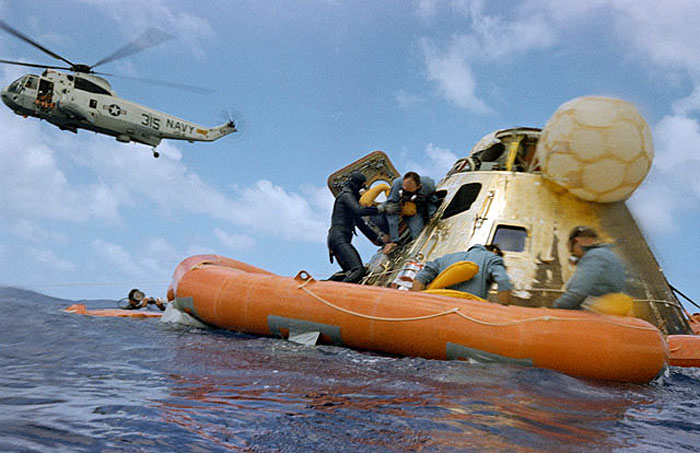
S69-22265 (24 Nov. 1969) --- Astronaut Alan L. Bean, lunar module pilot, is assisted with egressing the Apollo 12 Command Module by a U.S. Navy underwater demolition team swimmer during recovery operations in the Pacific Ocean. Already in the life raft are astronauts Charles Conrad Jr., commander; and Richard F. Gordon Jr., command module pilot. The three crewmen of the second lunar landing mission were picked up by recovery helicopter and flown to the prime recovery ship, USS Hornet. The Apollo 12 splashdown occurred at 2:58 p.m. (CST), Nov. 24, 1969, near American Samoa. While astronauts Conrad and Bean descended in the Lunar Module (LM) "Intrepid" to explore the Ocean of Storms region of the moon, astronaut Gordon remained with the Command and Service Modules (CSM) "Yankee Clipper" in lunar orbit.
-
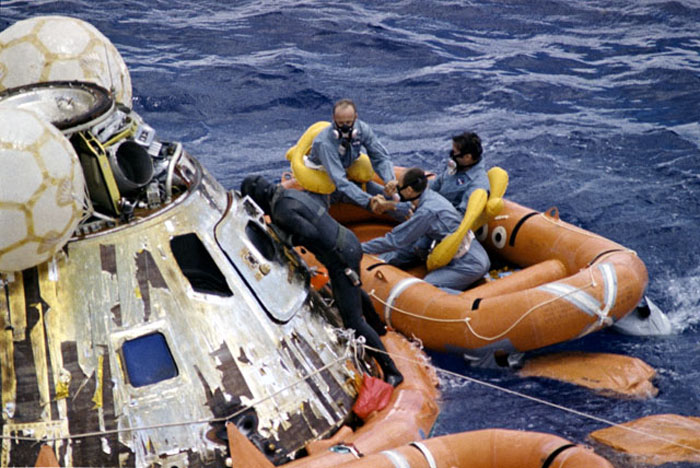
S69-22271 (24 Nov. 1969) --- A United States Navy Underwater Demolition Team swimmer assists the Apollo 12 crew during recovery operations in the Pacific Ocean. In the life raft are astronauts Charles Conrad Jr. (facing camera), commander; Richard F. Gordon Jr. (middle), command module pilot; and Alan L. Bean (nearest camera), lunar module pilot. The three crew men of the second lunar landing mission were picked up by helicopter and flown to the prime recovery ship, USS Hornet. Apollo 12 splashed down at 2:58 p.m. (CST), Nov. 24, 1969, near American Samoa. While astronauts Conrad and Bean descended in the Lunar Module (LM) "Intrepid" to explore the Ocean of Storms region of the moon, astronaut Gordon remained with the Command and Service Modules (CSM) "Yankee Clipper" in lunar orbit.
-
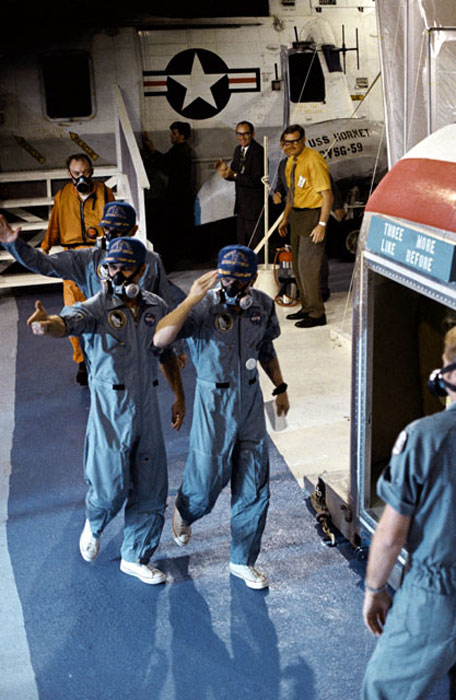
S69-22849 (24 Nov. 1969) --- USS Hornet crewmen are greeted by the crew of the Apollo 12 lunar landing mission as the three astronauts are transferred from a U.S. Navy helicopter to a Mobile Quarantine Facility (MQF) aboard the prime recovery vessel. Charles Conrad Jr., right, commander; Richard F. Gordon Jr., command module pilot, left front; and Alan L. Bean, lunar module pilot, splashed down safely at 2:58 p.m., Nov. 24, 1969.
.

S69-22876 (24 Nov. 1969) --- Rear Admiral Donald C. David, Commander, Manned Spacecraft Recovery Force, Pacific, welcomes the crew of the Apollo 12 lunar landing mission aboard the USS Hornet, prime recovery vessel for the mission. A color guard was also on hand for the welcoming ceremonies. Inside the Mobile Quarantine Facility (MQF) are (left to right) astronauts Charles Conrad Jr., commander; Richard F. Gordon Jr., command module pilot; and Alan L. Bean, lunar module pilot.
.
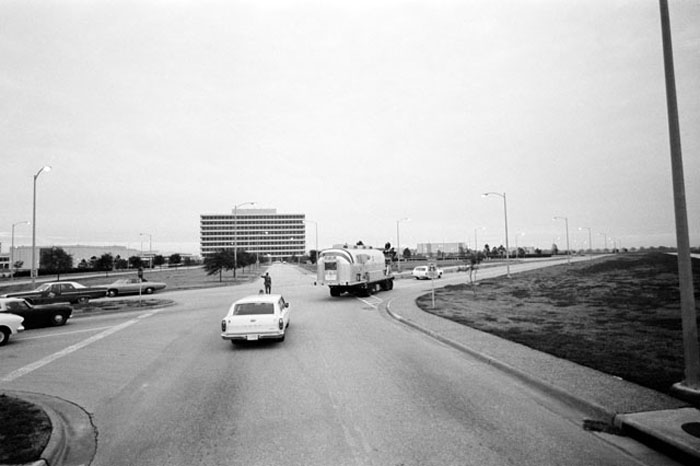
S69-60644 (29 Nov. 1969) --- A Mobile Quarantine Facility (MQF), with the crew men of the Apollo 12 lunar landing mission aboard, arrived at the Manned Spacecraft Center (MSC) Saturday morning, Nov. 29, 1969. Astronauts Charles Conrad Jr., Richard F. Gordon Jr., and Alan L. Bean were on their way to the Lunar Receiving Laboratory (LRL) where they will remain in quarantines until Dec. 10, 1969. Minutes earlier the three astronauts had arrived at Ellington Air Force Base from Hawaii aboard a U.S. Air Force C-141 transport. The crewmen were confined to the MQF from splashdown until they arrived at the LRL.
.

S69-60759 (29 Nov. 1969) --- Members of the Apollo 12 lunar landing mission's crew are greeted by their wives and children at the front of a large crowd on hand to welcome the three home. The Mobile Quarantine Facility (MQF), with the crew inside, arrived at Ellington Air Force Base aboard a United States Air Force C-141 transport jet in the early morning hours of Nov. 29, 1969. The crew men, looking out the MQF window at the crowd, are from left to right, astronauts Charles Conrad Jr., Richard F. Gordon Jr. and Alan L. Bean. Their wives are, from left to right, Mrs. Barbara Gordon, Mrs. Jane Conrad and Mrs. Sue Bean. The women are wearing lei's, an Hawaiian tradition. The crew members were taken to Hawaii from their Pacific Ocean recovery site aboard the USS Hornet, prime recovery vessel for the mission.
-

S69-60760 (29 Nov. 1969) --- Members of the Apollo 12 lunar landing mission's crew talk to their families from inside the Mobile Quarantine Facility (MQF) soon after their arrival at Ellington Air Force Base aboard a United States Air Force C-141 transport jet in the early morning hours of Nov. 29, 1969. The crew men, looking out the MQF window at the crowd, are from left to right, astronauts Charles Conrad Jr., Richard F. Gordon Jr., and Alan L. Bean. Some of the family members can be seen in lower right foreground. The crew members were taken to Hawaii from their Pacific Ocean recovery site aboard the USS Hornet, prime recovery vessel for the mission.
.
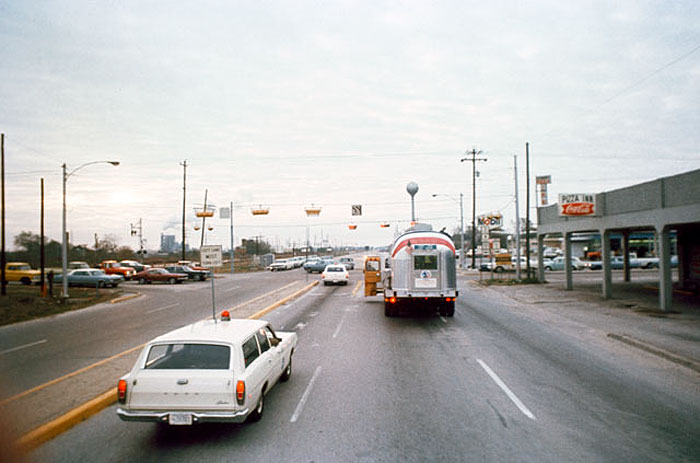
S69-60761 (29 Nov. 1969) --- A Mobile Quarantine Facility (MQF), with the crew of the Apollo 12 lunar landing mission aboard, is shown on the way from Ellington Air Force Base (EAFB) to the Manned Spacecraft Center's (MSC) Lunar Receiving Laboratory (LRL) Saturday morning, Nov. 29, 1969. Minutes earlier the astronauts had arrived at EAFB from Hawaii aboard a U.S. Air Force C-141 transport. Charles Conrad Jr., Richard F. Gordon Jr., and Alan L. Bean will remain in LRL quarantine until Dec. 10, 1969. The crew men were confined to the MQF from splashdown until they arrived at the LRL.
.
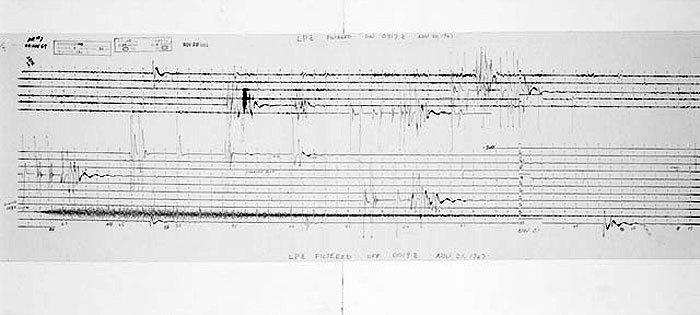
S69-59547 (20 Nov. 1969) --- The seismometer reading from the impact made by the Lunar Module ascent stage when it struck the lunar surface. The impact was registered by the Passive Seismic Experiment Package which was deployed on the moon by the Apollo 12 astronauts. PSEP, which is a component of the Apollo Lunar Surface Experiments Package, will detect surface tilt produced by tidal deformations, moonquakes, and meteorite impacts. The LM's ascent stage was jettisoned and sent journeying toward impact on the moon after astronauts Charles Conrad Jr. and Alan L. Bean returned to lunar orbit and rejoined astronaut Richard F. Gordon Jr. in the Command and Service Modules. Information from the PSEP is transmitted to Earth through the ALSEP's central station and monitored by equipment at the Manned Spacecraft Center.
.
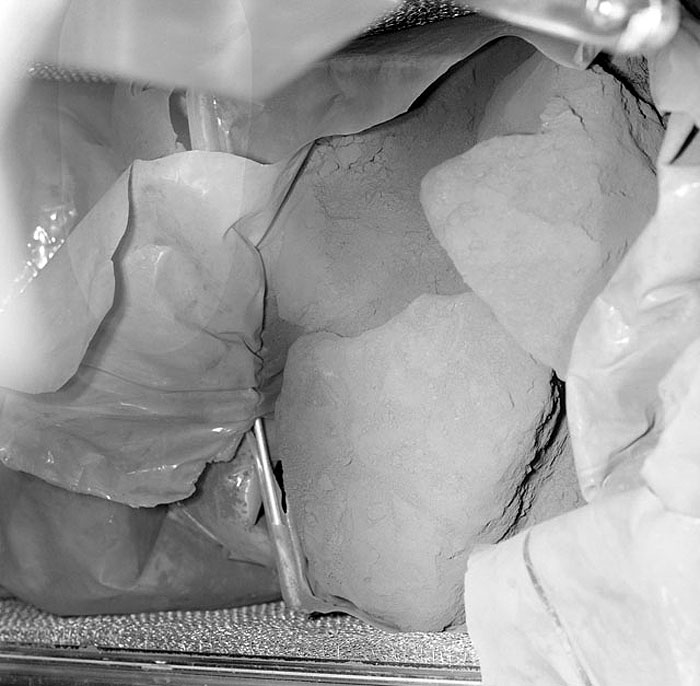
S69-60294 (26 Nov. 1969) --- One of the first views of the Apollo 12 lunar rocks is this photograph of the open sample return container. The large rock is approximately 7 1/2 inches across and is larger than any rock brought back to Earth by the crew of the Apollo 11 lunar landing mission. Two of the rocks in the first container are crystalline and generally lighter in color than those returned on the first lunar landing. The rocks in this box are medium charcoal brown/gray in color.
.
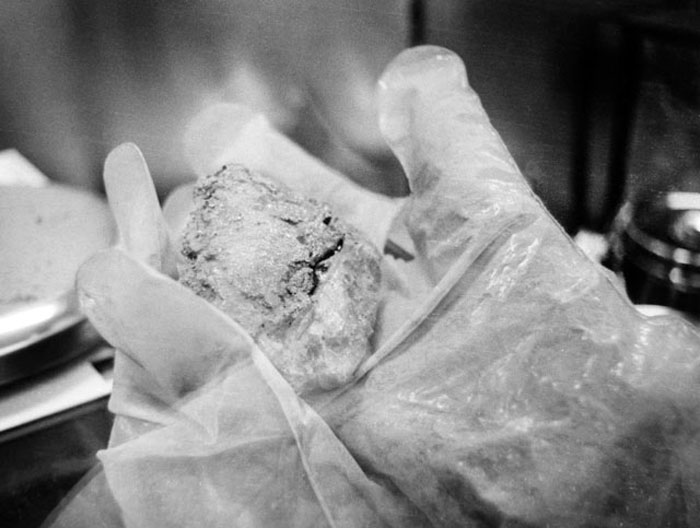
S69-60354 (29 Nov. 1969) --- A scientist's gloved hand holds one of the numerous rock samples brought back to Earth from the Apollo 12 lunar landing mission. The rocks are under thorough examination in the Manned Spacecraft Center's (MSC) Lunar Receiving Laboratory (LRL). This sample is a highly shattered basaltic rock with a thin black-glass coating on five of its six sides. Glass fills fractures and cements the rock together. The rock appears to have been shattered and thrown out by a meteorite impact explosion and coated with molten rock material before the rock fell to the surface.
.
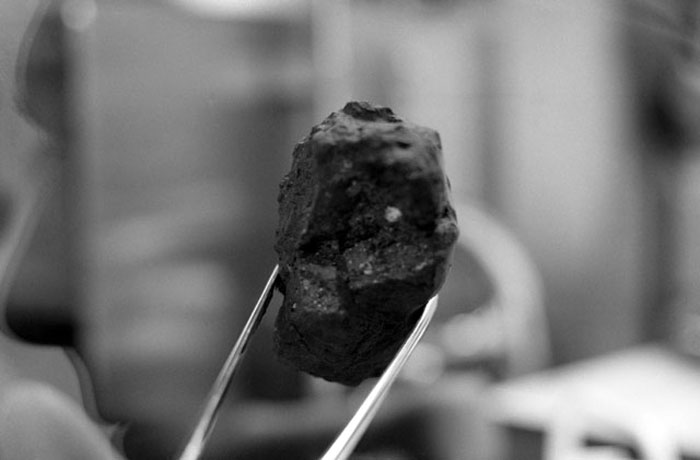
S69-60487 (1 Dec. 1969) --- A close-up view of one of the rocks brought back to Earth from the Apollo 12 lunar landing mission. The rock is under examination in the Physical-Chemical Test Laboratory in the Lunar Receiving Laboratory (LRL), Building 37, MSC. This rock is one of two breccia found in the contingency collection gathered by astronauts Charles Conrad Jr. and Alan L. Bean during their stay on the lunar surface. The breccia rocks, common in the collection of Apollo 11 lunar samples, have been rare in examinations of the Apollo 12 samples thus far.
.
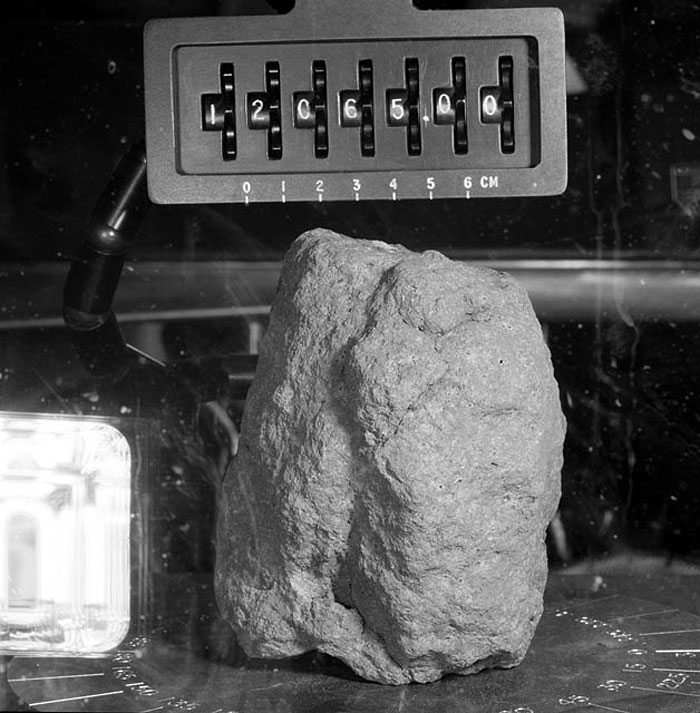
S69-60580 (November 1969) --- Close-up view of Apollo 12 sample 12,065 under observation in the Manned Spacecraft Center's (MSC) Lunar Receiving Laboratory (LRL). This sample, collected during the second Apollo 12 extravehicular activity (EVA) of astronauts Charles Conrad Jr. and Alan L. Bean, is a fine-grained rock. Note the glass-lined pits. Viewer can gain an idea of the size of the rock by reference to the gauge on the bottom portion of the number meter.
-
Fotos: NASA
4658 Views

